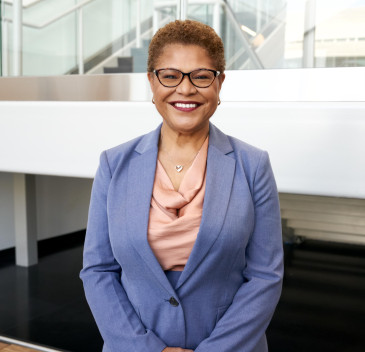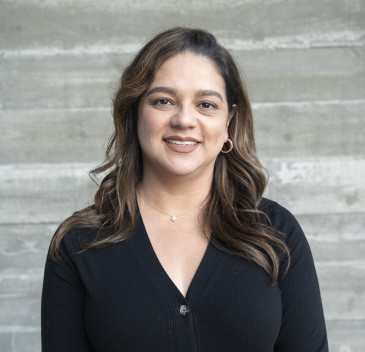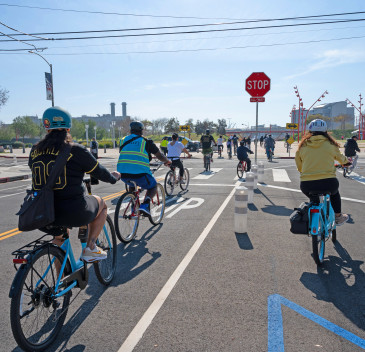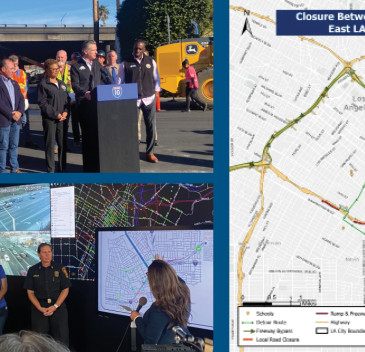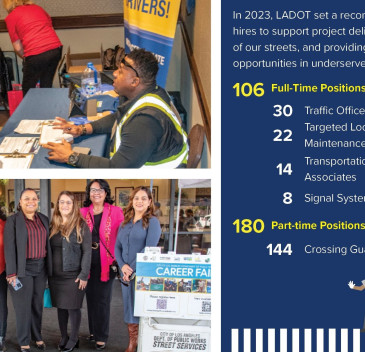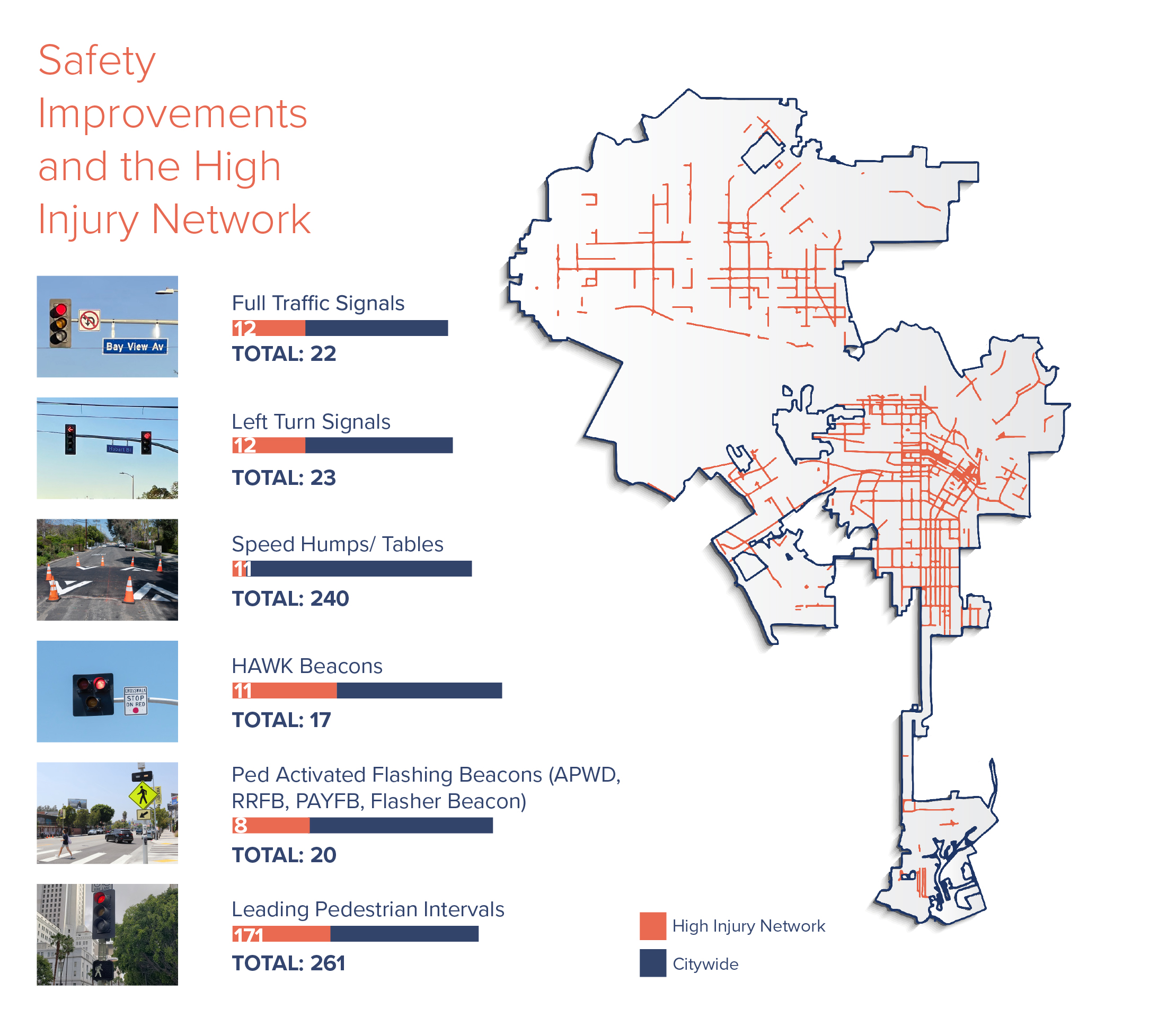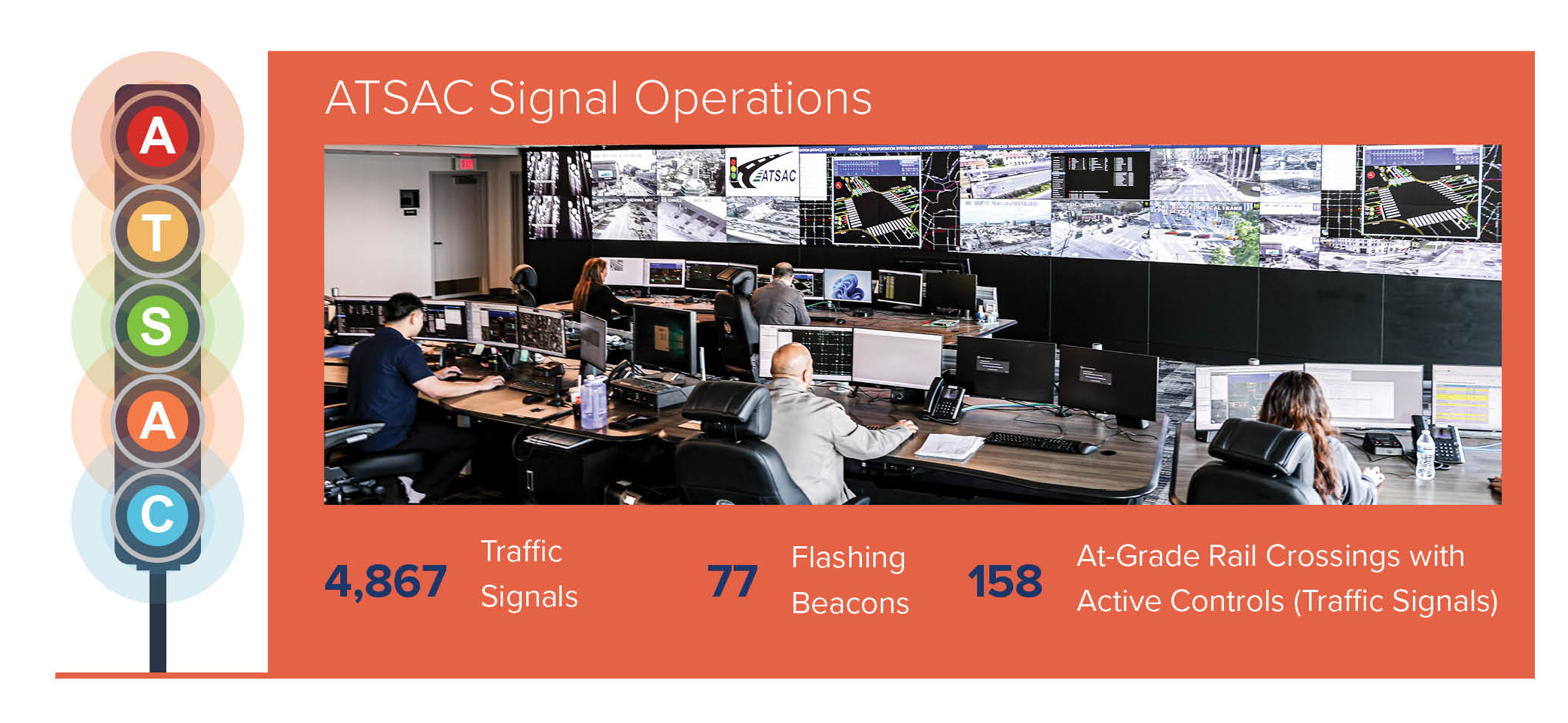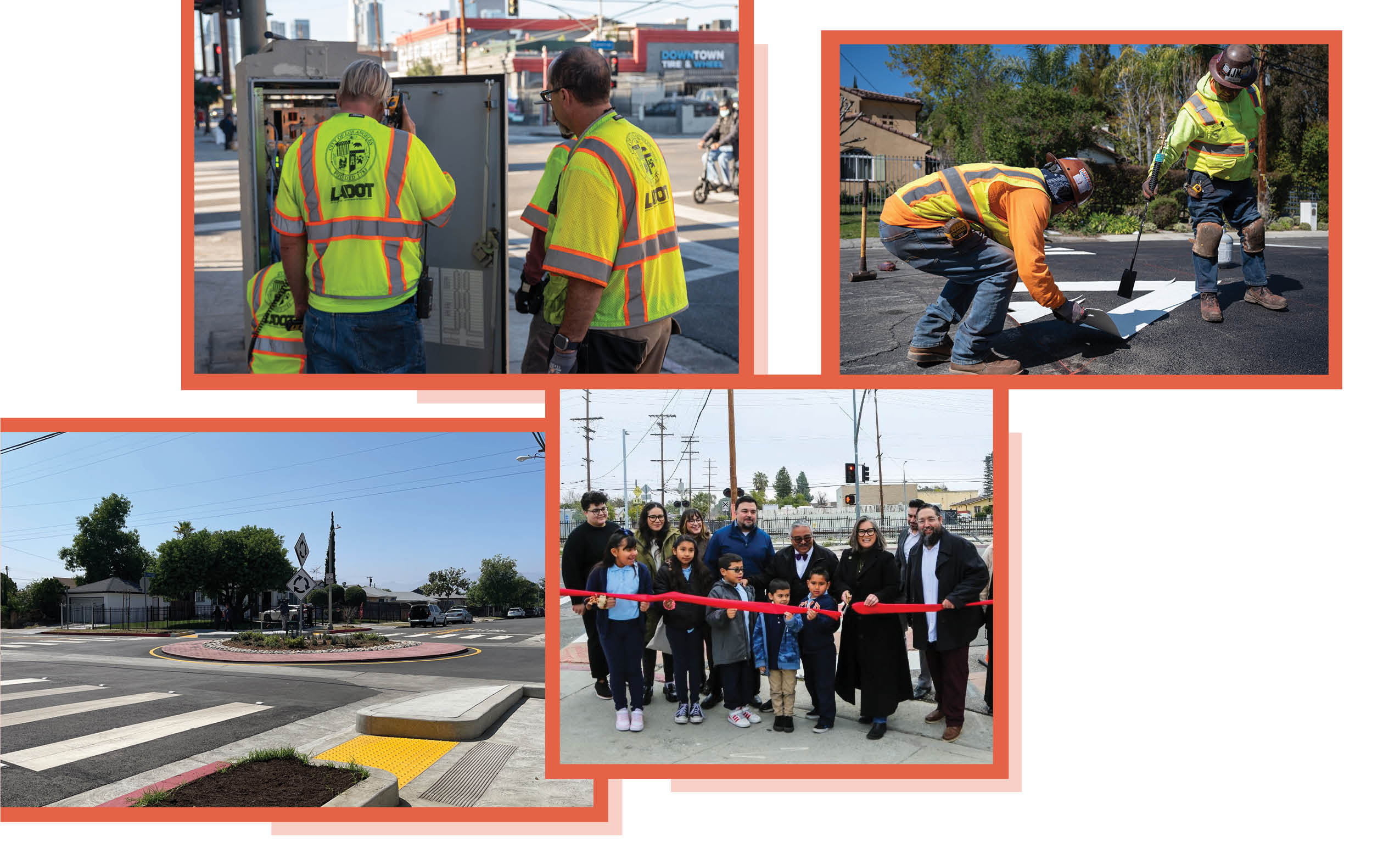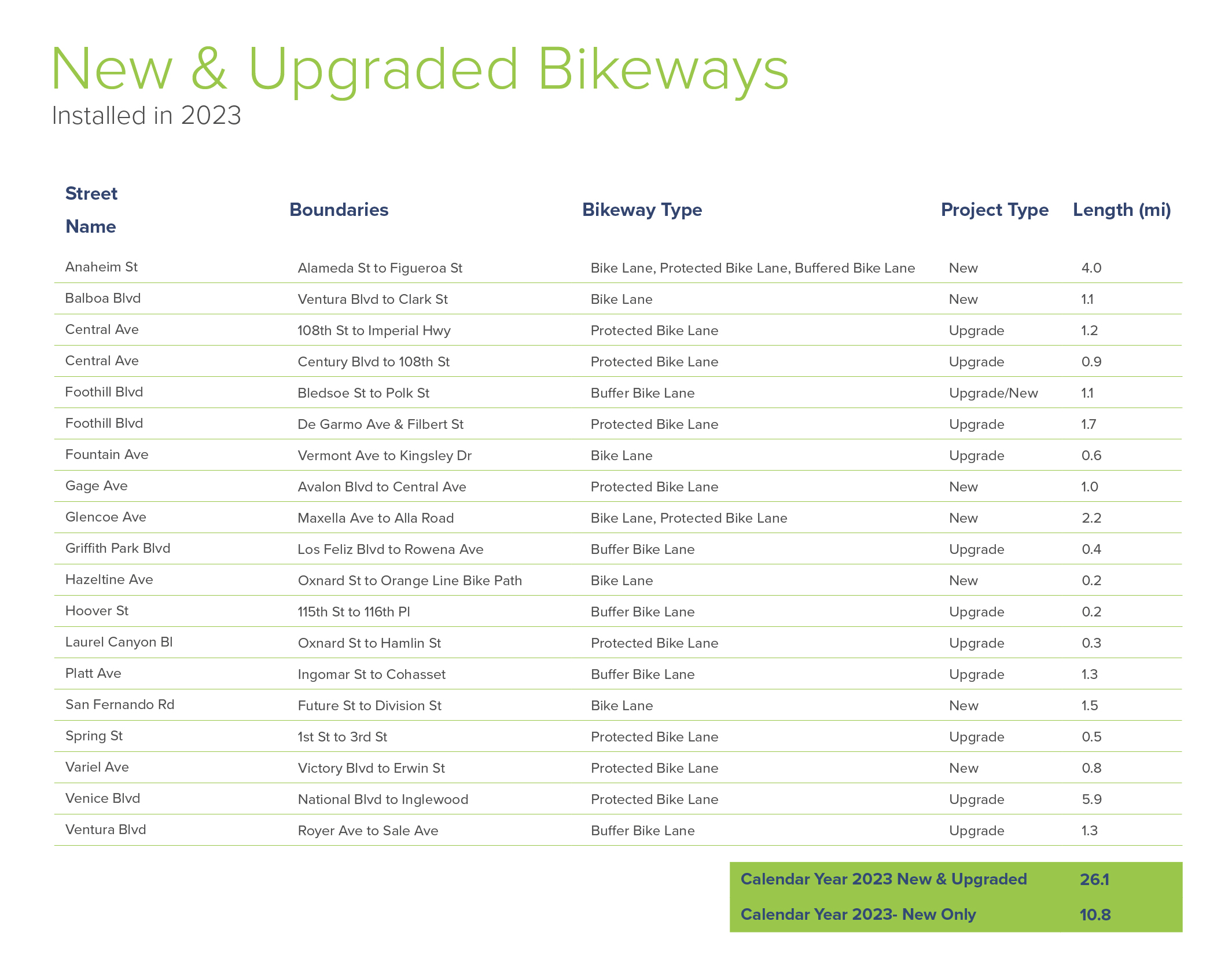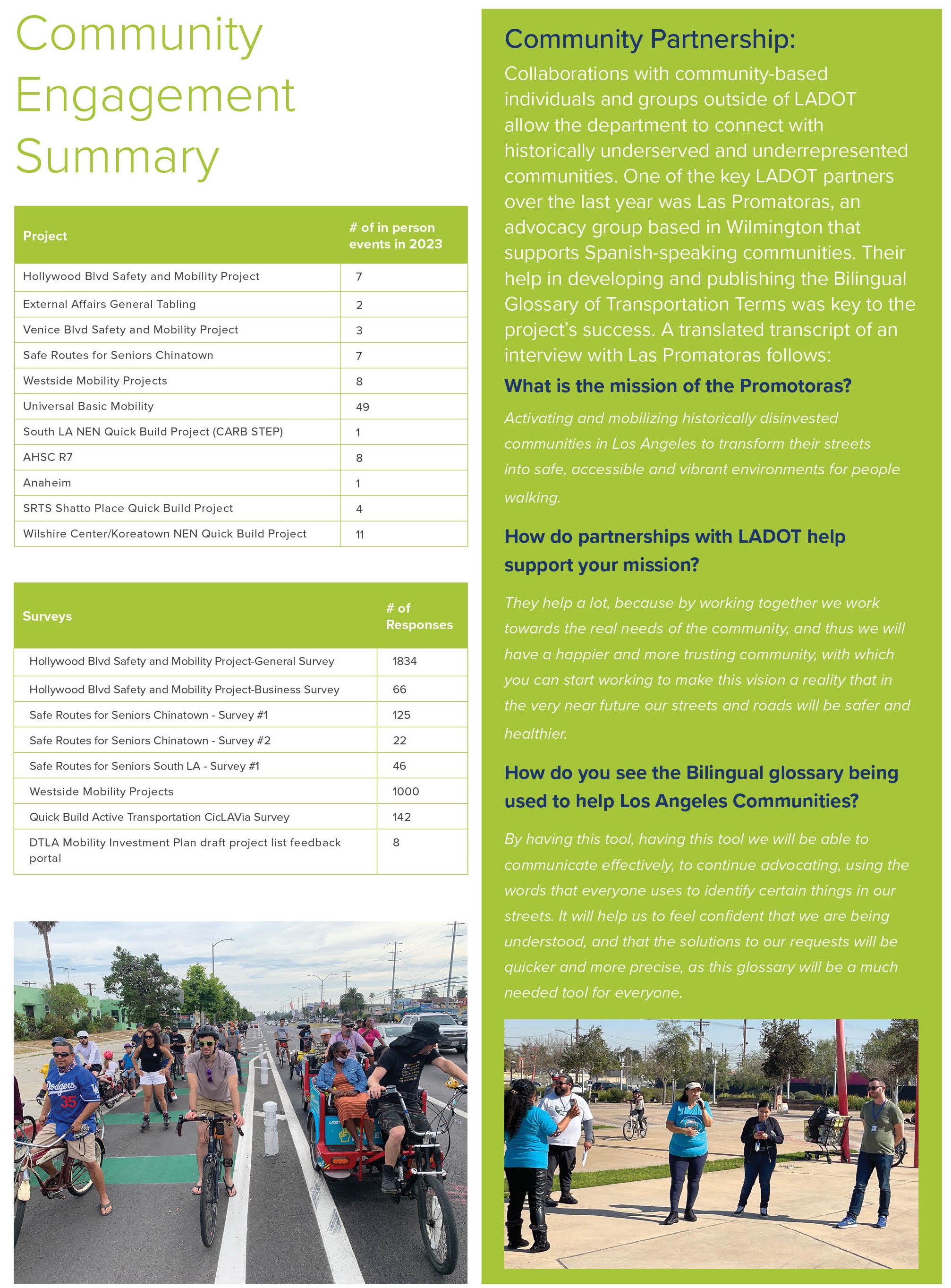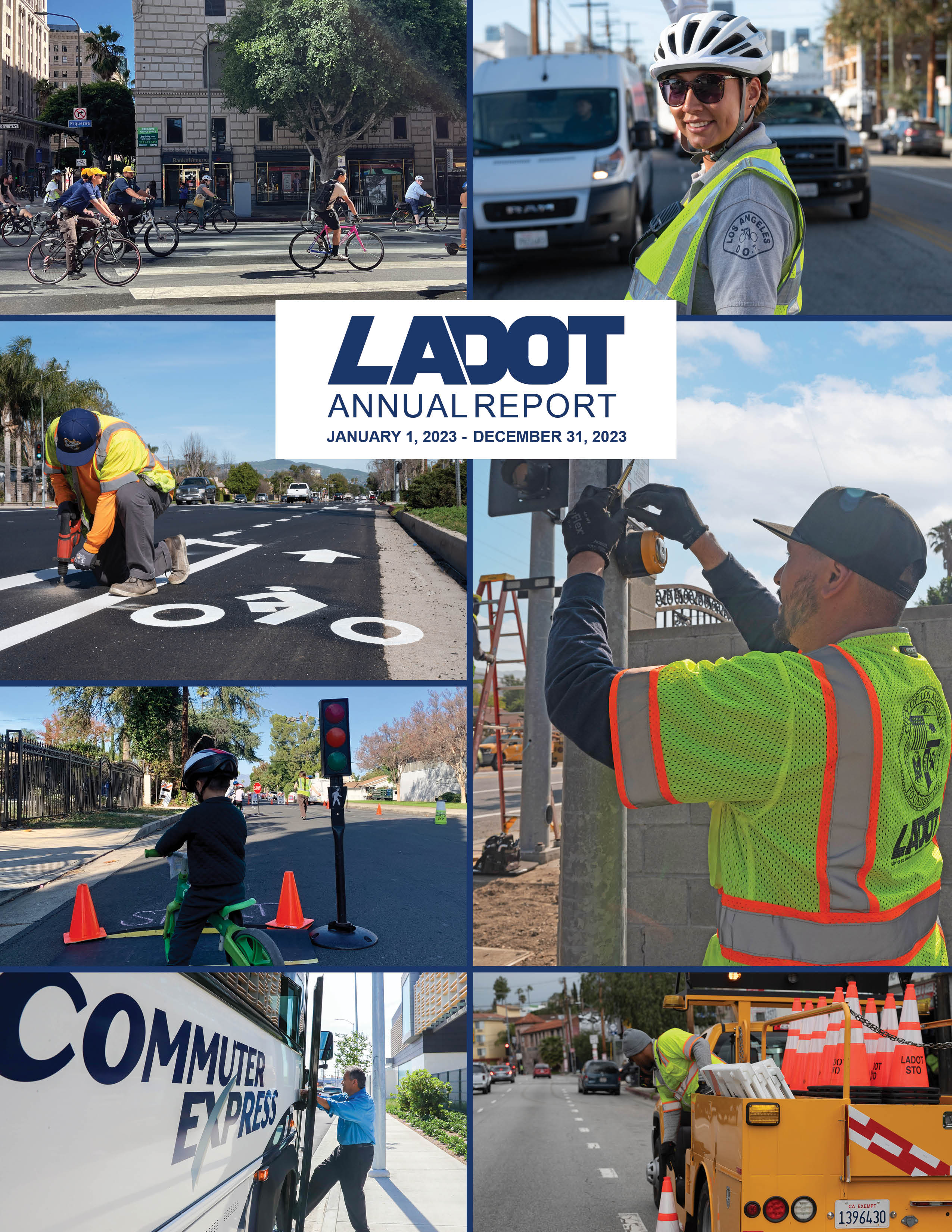
Message from Mayor Karen Bass
 Dear Community Members,
Dear Community Members,
Over the past year, the City of Los Angeles’ Department of Transportation (LADOT) has served an important role in moving our city forward on projects that make streets safer while helping support our city during unexpected challenges.
Department staff proved their resilience, resourcefulness, and dedication as the City responded to emergencies like Tropical Storm Hilary and the I-10 freeway closure. Working with local, state, and federal partners, LADOT was crucial to keeping roads safe and clear, and ultimately, limiting the impacts of these events on our communities. The I-10 freeway was reopened after just nine days– weeks ahead of initial estimates–proving that our City is prepared to act quickly in response to a crisis.
LADOT projects are also making the City more livable, sustainable, and welcoming for all. The new La Brea, Venice, and Sepulveda bus only lanes improve access to job centers and neighborhood resources as well as make transit more reliable and efficient.
I know LADOT will continue to deliver projects like these that move our City forward. I look forward to the continued collaboration with the many hardworking LADOT employees who bring these projects to life and serve our City with pride.
Sincerely,
Mayor Karen Bass
Message from General Manager Laura Rubio-Cornejo
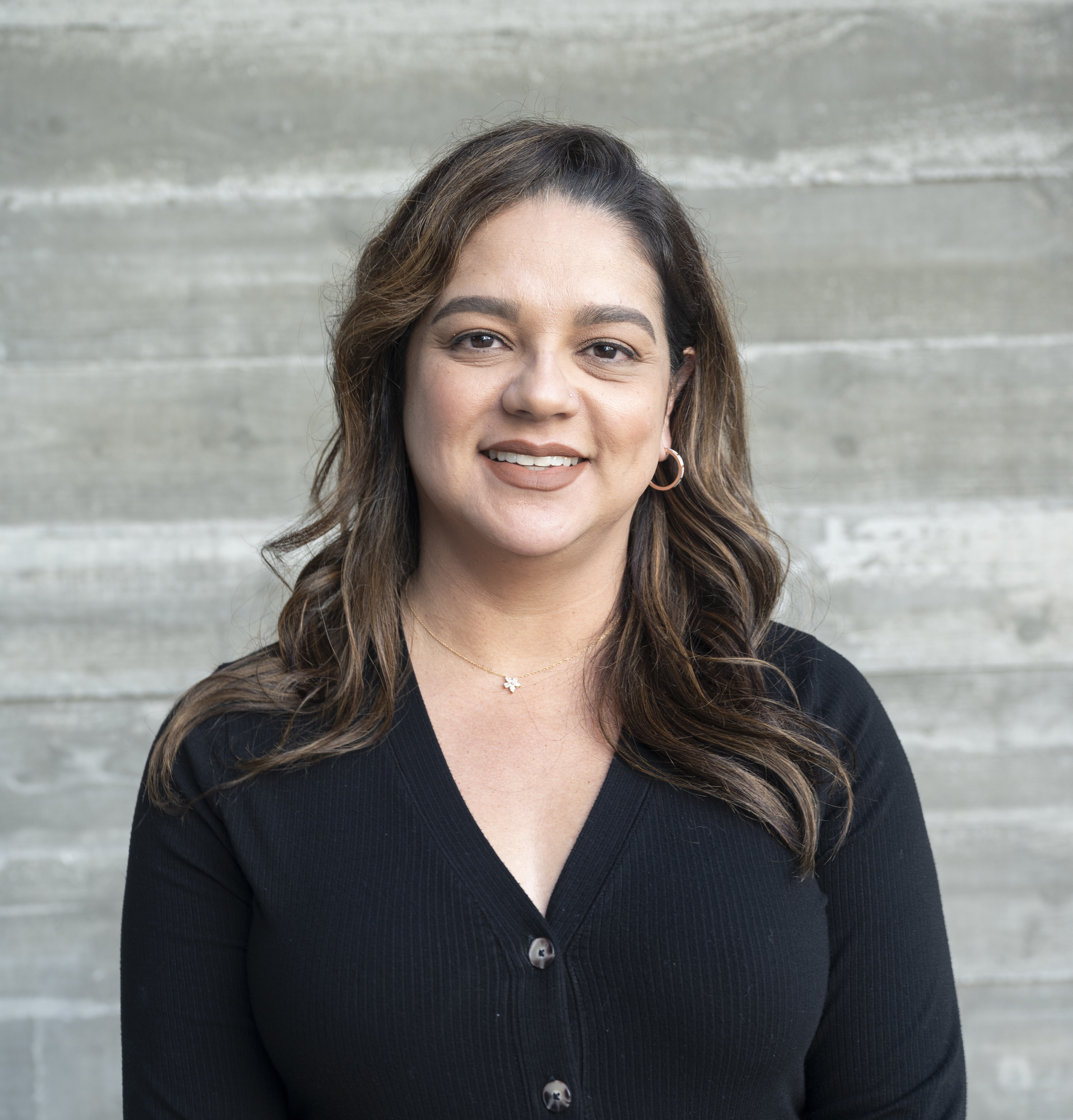
Dear Community,
I am pleased to present LADOT’s 2023 Annual Report, my first as General Manager. It has been an honor to join the City of Los Angeles team and continue LADOT’s work to advance transportation safety, accessibility, and reliability. This was a landmark year for transportation in our City, and I am proud to share our accomplishments with you.
Through Mayor Bass’ leadership, 2023 marked the City’s most significant investment in school safety. Leading up to the 2023-2024 school year, LADOT implemented school slow zones with 15 mile per hour speed limits at more than 200 schools, constructed speed humps at over 50 schools, and hired a record number of new crossing guards. We’ll continue this investment into 2024 as we expand the program to 150 additional schools before the end of the school year.
As the City continued its recovery from the COVID-19 pandemic, LADOT’s DASH and Commuter Express buses saw increased ridership, nearly returning to pre-pandemic levels. To further improve bus service, LADOT partnered with LA Metro to double the network of dedicated bus-only lanes with projects along the key corridors of Venice, La Brea, and Sepulveda. Bus only lanes are a common sense solution that keeps bus service running on time, improving reliability for our transit customers, and making public transportation a more attractive alternative to driving.
None of this great work would be possible without the dedicated women and men at LADOT. To continue to support these dedicated public services, LADOT also increased hiring in 2023, as we worked to restore staff and services that faced cuts as a result of the economic impacts of the COVID-19 pandemic.
As we head into 2024, LADOT remains committed to serving the City we love with pride and purpose. In just a few years, Los Angeles will host both the 2026 World Cup and the 2028 Olympic and Paralympic Games. LADOT’s goal is to plan and prepare for these events while continuing to improve the services our communities depend upon every day. As our City gears up to welcome the world, I know it is just as important to deliver for those who call Los Angeles home.
I want to thank all the LADOT employees who made my transition into the role of GM a smooth one. I look forward to working with this dedicated team to deliver an exciting future for mobility in Los Angeles.
Sincerely,
Laura Rubio-Cornejo

Health and Safety
Prioritizing Safety on LA Streets
No one should be injured or lose their life due to preventable traffic violence. Tragically, in 2023 there were 336 fatalities in Los Angeles, making LADOT’s work to reduce and ultimately eliminate traffic deaths more important than ever.
In order to expedite critical safety projects, LADOT prioritized hiring to expand capacity for the Vision Zero and Active Transportation divisions, filling multiple engineering and planning positions. This additional staff will allow the department to move faster on designing and implementing a larger number of projects.
LADOT also completed projects to increase safety by redesigning streets on key corridors such as Anaheim St in Wilmington, Venice Blvd on the Westside, and Reseda Blvd in the San Fernando Valley. And at key locations across the city, LADOT installed over 550 safety treatments signal improvements, new stop signs, traffic circles, speed humps, and other treatments proven to calm traffic and reduce fatal collisions.
LADOT also focused on delivering safety programs targeted at the most vulnerable road users:
children and seniors. In the summer of 2023, LADOT launched an effort to improve school safety through quick build projects like lowered speed limits, curb extensions, and speed humps that will bring safety improvements to nearly 250 schools by the end of the 23/24 school year. LADOT’s Safe Routes For Seniors Pilot empowers older adults to identify transportation and safety needs within their communities with the goal of eliminating crashes as well as increasing walking and biking, reducing isolation, and improving health outcomes. In 2023, the Safe Routes for Seniors team completed a seven-month outreach and engagement phase in Chinatown and Rancho Park.
Even amidst a nationwide wave of increasing traffic violence, the locations where LADOT invests in safety show a reduction in collisions and fewer deaths. Los Angeles must remain committed to a future where no family or community is forced to endure the kind of heartbreaking loss that impacts too many today.
School Safety Zones
Traffic collisions are the leading cause of 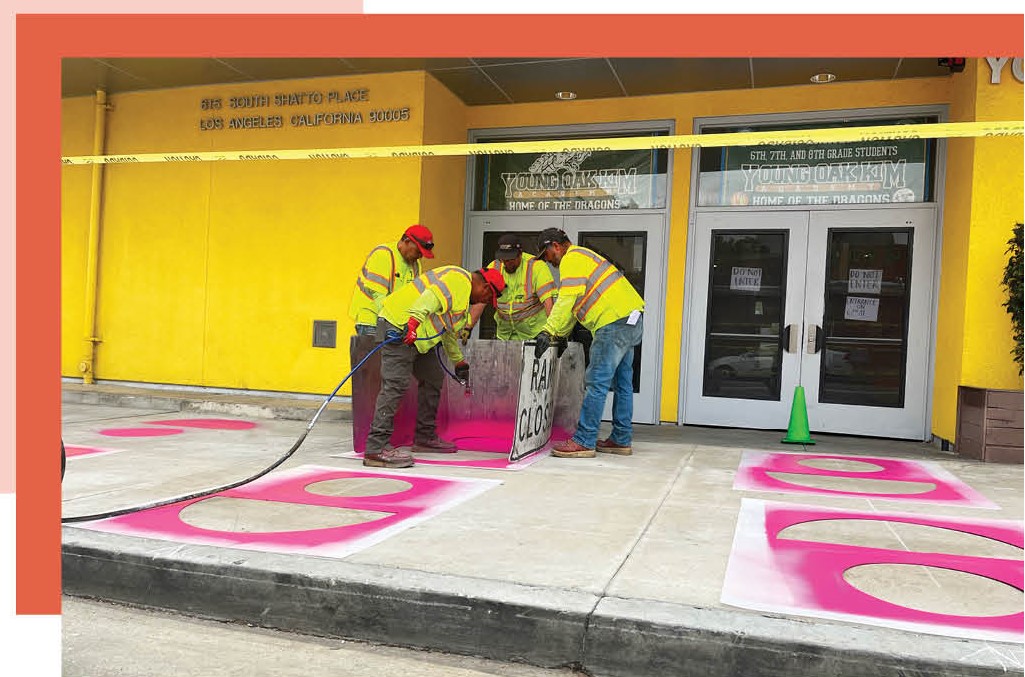 death for children between 2 and 14 years old in Los Angeles County. With nearly 56 percent of all fatal and severe injury collisions occurring within a one-quarter mile of a school, LADOT understands that keeping students safe on their way to and from school is a key priority for the department’s efforts to improve safety on City streets. In 2023, at the direction of Mayor Karen Bass and the Los Angeles City Council, LADOT developed and began implementing the largest school safety program in our City’s history to deliver treatments that reduce speeding and other dangerous driving behavior near schools.
death for children between 2 and 14 years old in Los Angeles County. With nearly 56 percent of all fatal and severe injury collisions occurring within a one-quarter mile of a school, LADOT understands that keeping students safe on their way to and from school is a key priority for the department’s efforts to improve safety on City streets. In 2023, at the direction of Mayor Karen Bass and the Los Angeles City Council, LADOT developed and began implementing the largest school safety program in our City’s history to deliver treatments that reduce speeding and other dangerous driving behavior near schools.
Using LADOT’s Safe Routes To School (SRTS) methodology, LADOT identified schools of highest need based on the number of nearby collisions, the number of students that live within a ¼ mile, the number of students eligible for free or reduced meals, and the lack of other transportation funding. After initially identifying funding for 45 schools where speed limits could be reduced to 15 mph, the City Council subsequently authorized funding for LADOT to install School Safety Zones at an additional 200 schools in the fiscal year 23-24.
In addition to reducing speed limits, LADOT’s school safety zones also include the addition of speed humps and quick-build crosswalk upgrades that reduce the exposure of children crossing the street at intersections near schools.
Improvements like these don’t just make school-age Angelenos safer in the short term. By ensuring students can arrive safely at school through walking and biking, these changes help reduce dependence on driving and promote more sustainable travel behaviors. LADOT’s School Safety program will complete safety treatments at all schools identified by the end of the school year, but LADOT’s commitment to improving safety on Los Angeles streets, particularly for the most vulnerable users, will continue across all the department’s projects and operations.
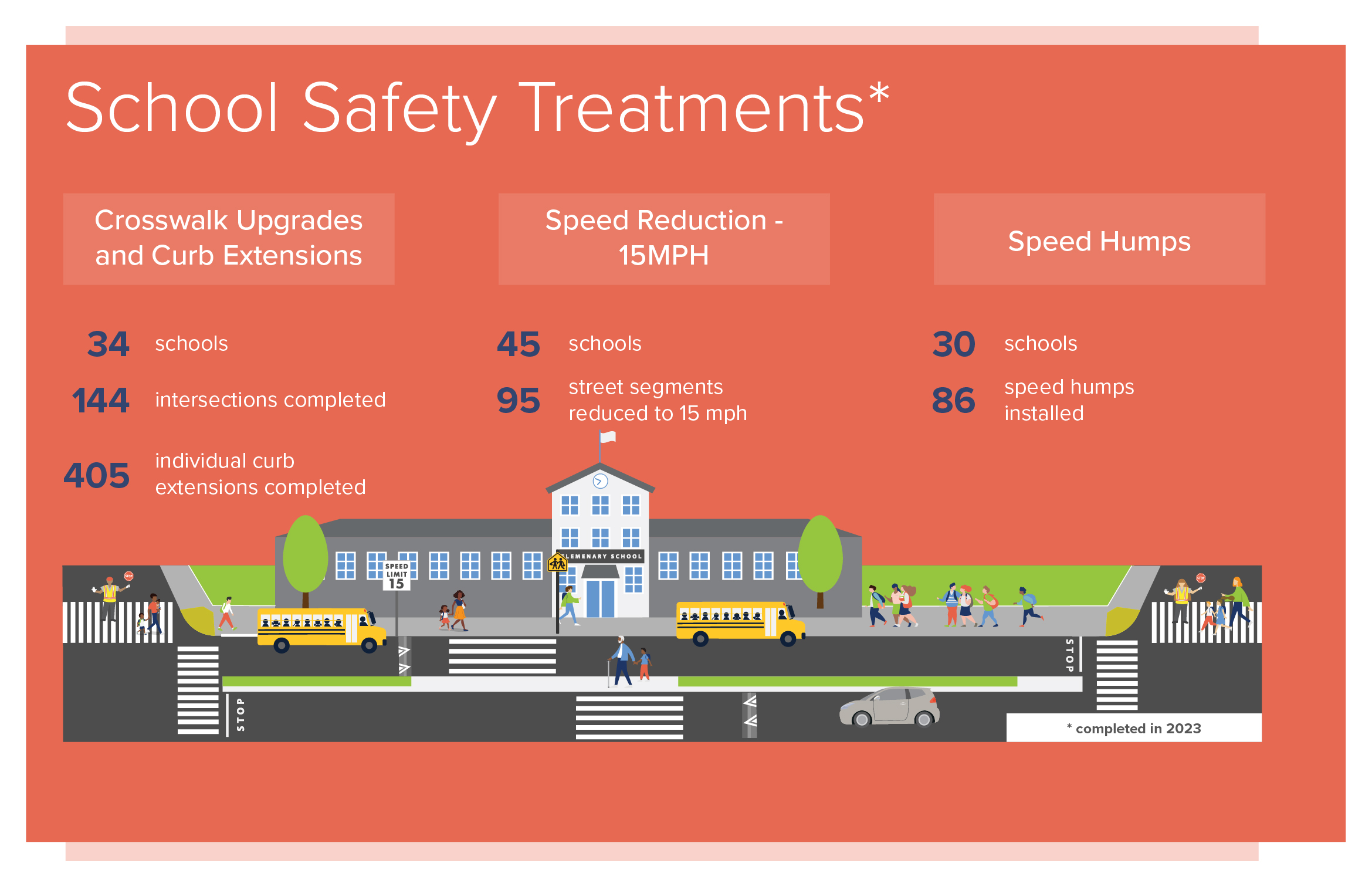
AB 645 Expands LADOT’s Safety Toolkit
In 2023, LADOT continued to advocate for state-level  legislation to provide municipalities like Los Angeles more tools and resources to develop programs that make streets safe. The speed safety camera pilot program signed by Governor Newsom in the fall of 2023 has the potential to transform how we can ensure safe driving and accountability on LA streets. Introduced by CA State Assemblymember Laura Friedman, the bill allows certain jurisdictions, including the City of Los Angeles, to conduct a five-year pilot to evaluate the effectiveness of speed cameras in school zones and on streets with a history of crashes and street races.
legislation to provide municipalities like Los Angeles more tools and resources to develop programs that make streets safe. The speed safety camera pilot program signed by Governor Newsom in the fall of 2023 has the potential to transform how we can ensure safe driving and accountability on LA streets. Introduced by CA State Assemblymember Laura Friedman, the bill allows certain jurisdictions, including the City of Los Angeles, to conduct a five-year pilot to evaluate the effectiveness of speed cameras in school zones and on streets with a history of crashes and street races.
Every year, thousands of Californians die in speed-related traffic collisions and tens of thousands are injured. Speed is the most important factor in determining the severity of a crash, making speed safety cameras a vital tool for keeping streets safe. Speed safety cameras can also serve as an alternative to traffic stops by law enforcement that put drivers of color at risk due to implicit and explicit racial bias.
The passage of AB 645 will enable Los Angeles to install 125 speed safety cameras in selected locations with the goal of reducing speeding without disproportionately burdening low-income communities of color. Policymakers will be able to use data from this pilot program to make better informed decisions regarding the statewide implementation of speed safety cameras.
Speed safety cameras have proven effective in other cities at reducing injuries and saving lives. In the next year, LADOT will begin the pilot program by identifying locations for the speed cameras through a public process and community engagement.
Project Delivery
New Bus Priority Lanes Debut Across Los Angeles
Traffic congestion is a major barrier to the efficiency and reliability of public transit. When buses are stuck in traffic, travel times go up and transit reliability goes down. To avoid these issues, riders who are able may choose to travel by car instead, increasing congestion and making the problem even worse. Riders who cannot access a personal vehicle are further disadvantaged by arriving behind schedule. Idling buses and cars also contribute emissions, working against LA’s goal of a sustainable and environmentally friendly City. In 2023, LADOT worked to address this issue by partnering with Metro to form the Bus Speed Engineering Working Group to bring priority bus lanes to areas of particular high demand in order to support riders and service reliability. Venice Blvd, La Brea Ave, and Sepulveda Blvd all saw the installation of projects for over 13 miles of new bus priority lanes in 2023.

Venice Blvd
With 4 miles of 24-hour bus priority lanes, the Venice Blvd bus lanes serve almost 20,000 riders who board Metro Line 33 on an average weekday. Of that, a large majority are people of color, make less than $50k/year, do not own a car, and take Metro several times a week. The new bus priority lanes are part of LADOT and Metro’s Venice Boulevard Mobility Improvements Project, which brings safety upgrades like crosswalks, signal upgrades, and parking-protected bike lanes to Venice Blvd between Inglewood Blvd and National Blvd. 47,000 people live within a 5-minute walk of the project area and over half of these residents are people of color. The area has 36 schools and has connections to the Culver City Metro E Line Station. Venice Blvd is also part of the City’s High Injury Network (HIN) and sees a disproportionate amount of traffic collisions. By prioritizing bus lanes in this corridor, we improve travel times and reliability for thousands who live in this community as well as make Venice Blvd safer for pedestrians, transit users, and cyclists.
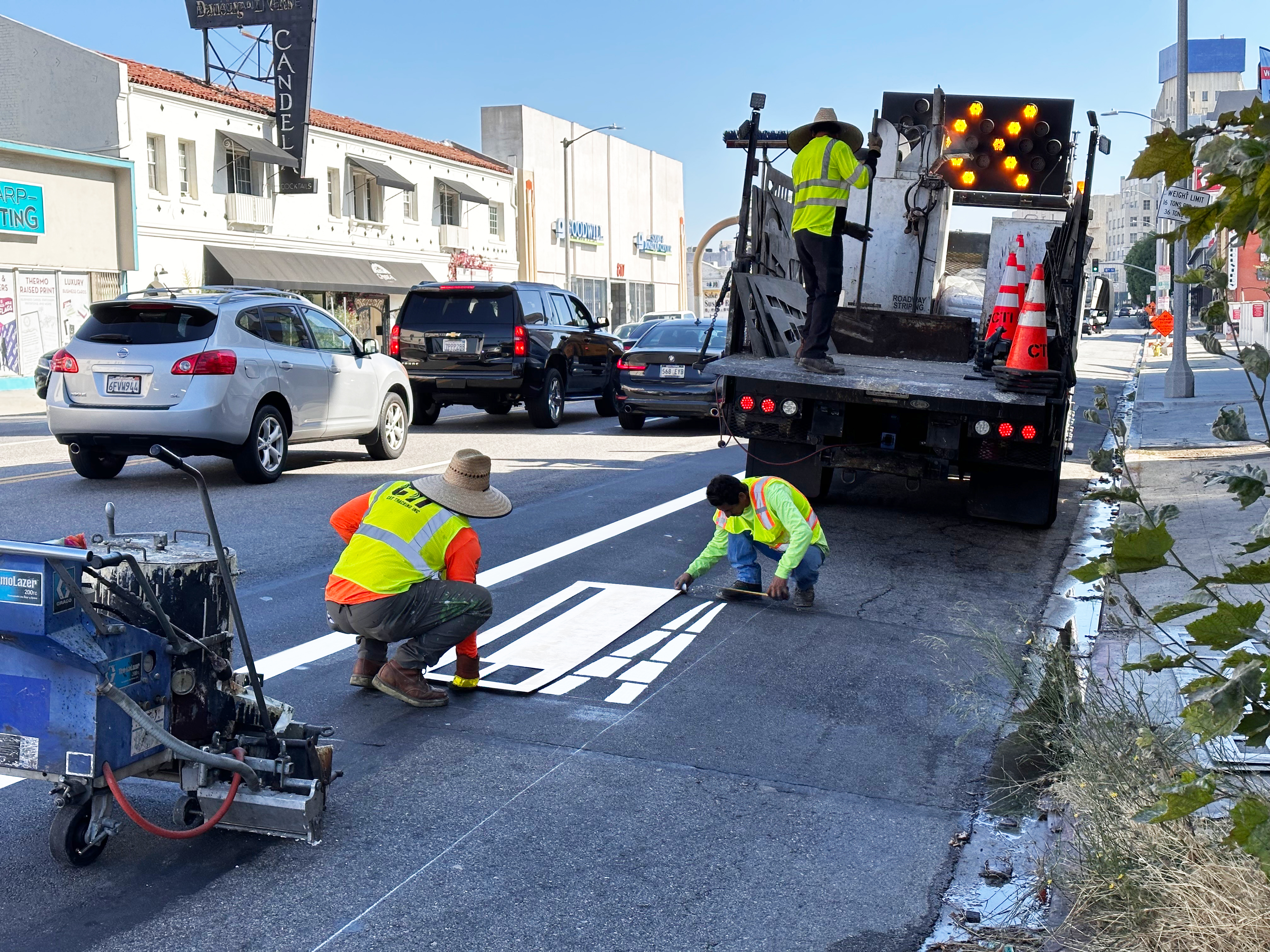
La Brea Ave
The La Brea Ave priority bus lanes run 2.8 miles between Sunset Blvd and Olympic Blvd during peak traffic periods, serving approximately 12,000 daily riders on Metro Line 212. Of those riders, 75% do not own a car, 90% are people of color, 40% are below the poverty line, and 95% take Metro at least several times per week. This segment is Phase I of the La Brea Ave Bus Priority Lanes project and improves bus speeds by 15 percent or more. The second phase, which is still in planning, will extend south from Olympic Blvd to Coliseum St and provide connections with the Metro E Line station.
Sepulveda Blvd
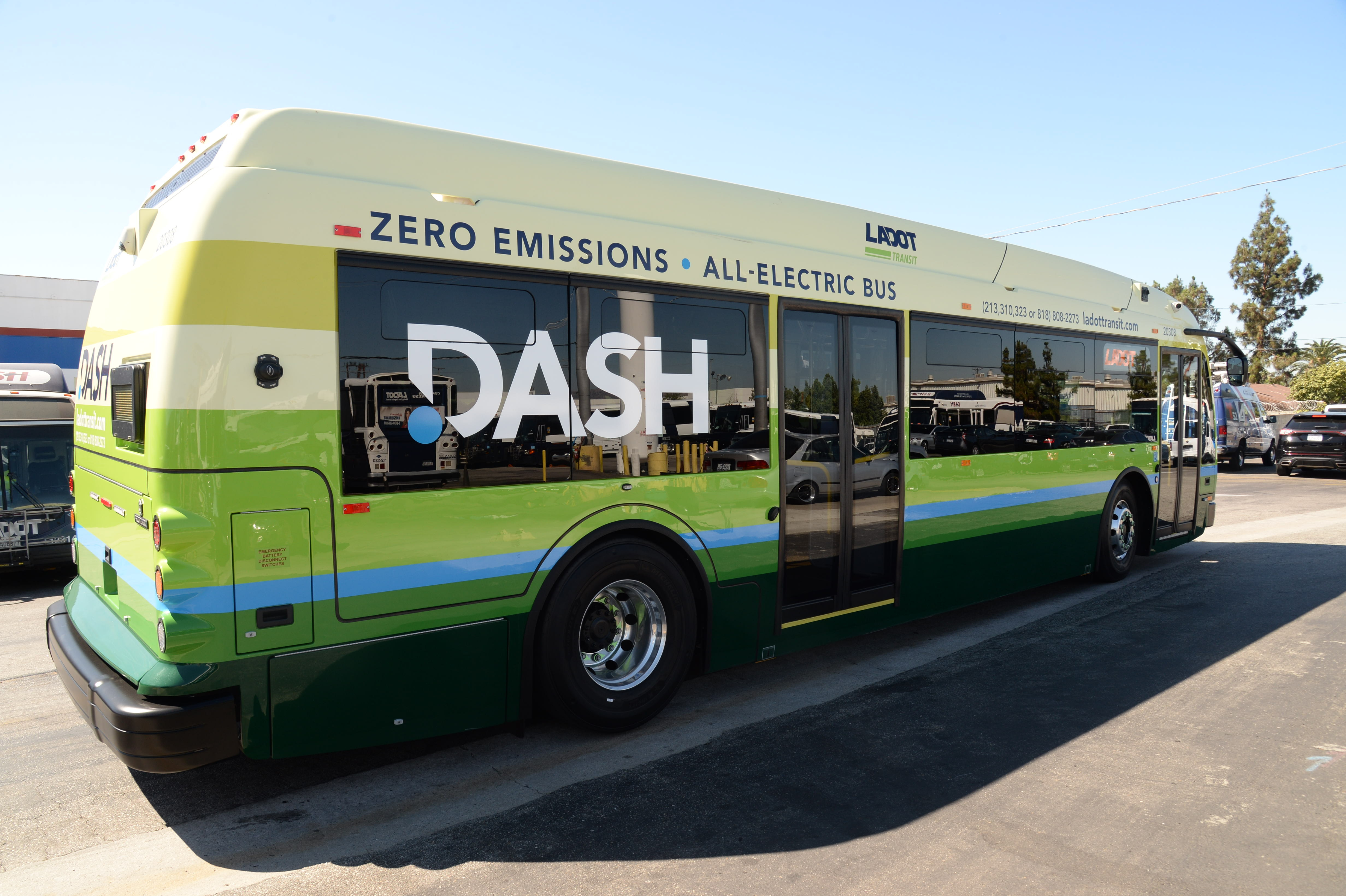
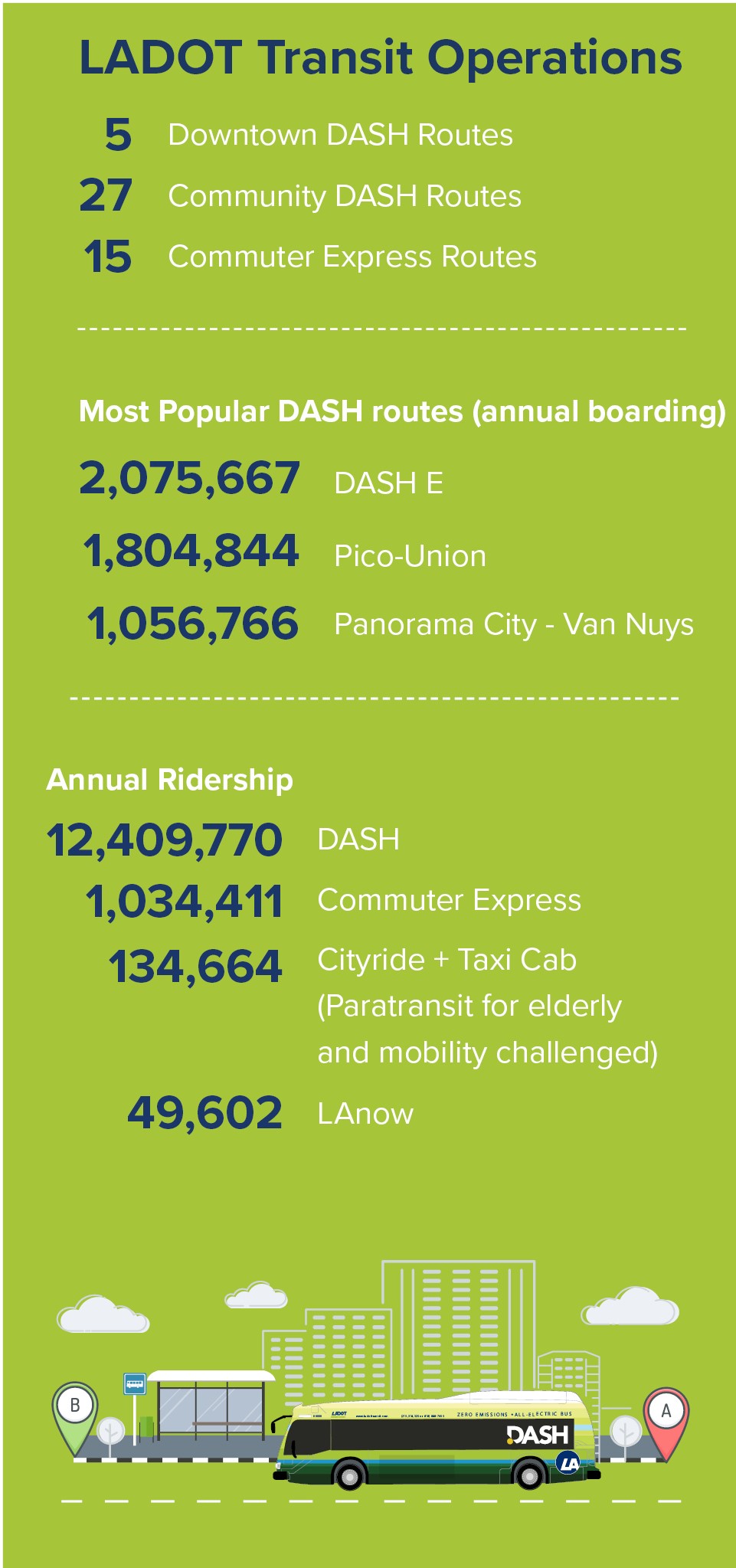 The first on-street bus only lanes in the Valley, the Sepulveda Blvd bus lanes are located along a 5.5-mile segment of Sepulveda Blvd from Ventura Blvd to Rayen St, and a 0.9-mile segment along westbound Ventura Blvd from Vesper Ave to Sepulveda Blvd. These lanes primarily serve the 9,000 weekday riders of Metro Line 234 and provide access to key locations like the Sherman Oaks Galleria, Valley Presbyterian Hospital, and the Sepulveda G Line Station.
The first on-street bus only lanes in the Valley, the Sepulveda Blvd bus lanes are located along a 5.5-mile segment of Sepulveda Blvd from Ventura Blvd to Rayen St, and a 0.9-mile segment along westbound Ventura Blvd from Vesper Ave to Sepulveda Blvd. These lanes primarily serve the 9,000 weekday riders of Metro Line 234 and provide access to key locations like the Sherman Oaks Galleria, Valley Presbyterian Hospital, and the Sepulveda G Line Station.
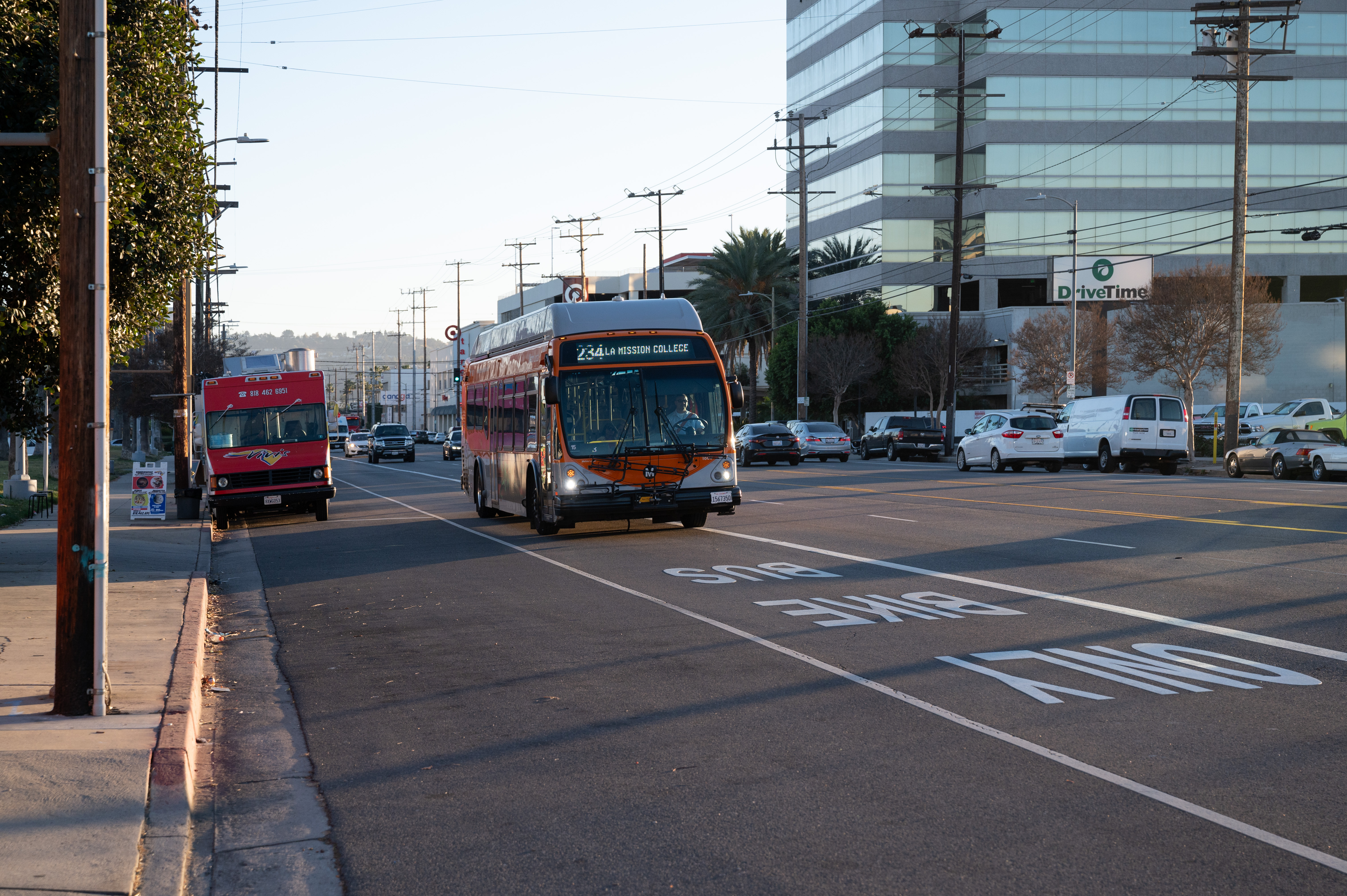
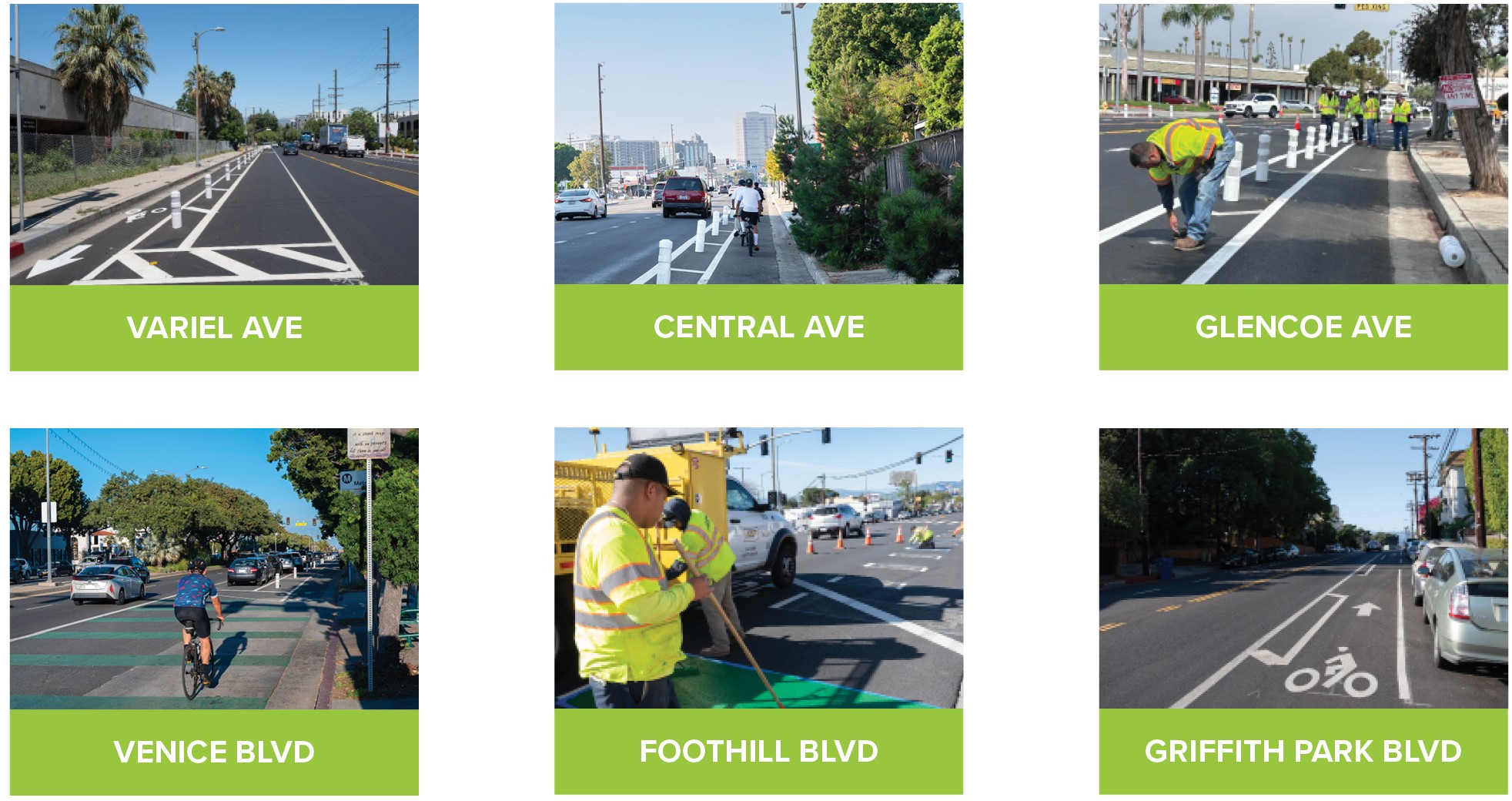
Expanding Transportation Options
The way we move matters. Choosing 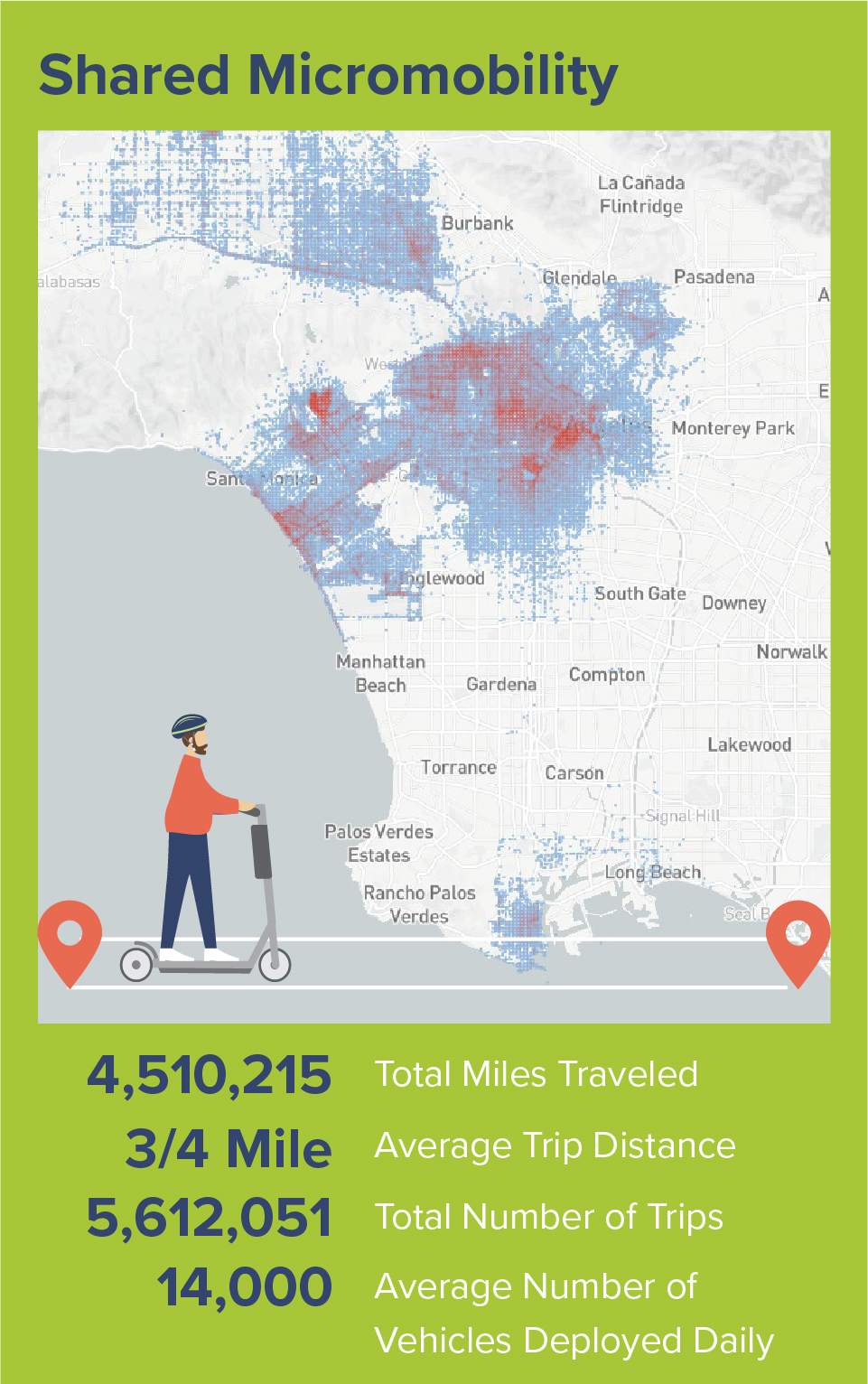 emissions-free transportation options reduces air pollution, increases quality of life, and helps create a sustainable future. LADOT is committed to expanding access and availability of emissions-free transportation in Los Angeles by promoting carbon-free shared vehicles such as Metro Bike, for-hire scooters, and electric vehicles and improving bicycle infrastructure across the City.
emissions-free transportation options reduces air pollution, increases quality of life, and helps create a sustainable future. LADOT is committed to expanding access and availability of emissions-free transportation in Los Angeles by promoting carbon-free shared vehicles such as Metro Bike, for-hire scooters, and electric vehicles and improving bicycle infrastructure across the City.
Through programs like LADOT’s bike share partnership with Metro and administering the largest private fleet of shared bikes and scooters in the country, LADOT enables Angelenos and visitors to take millions of trips a year without a car. This reduces congestion on LA streets and pollution in the air.
This effort is complemented by LADOT’s commitment to expand and improve upon the existing 1248 lane miles of bike facilities in Los Angeles. Over the past year, this included upgrading bike lanes on key corridors like Venice Blvd as well as installing brand new facilities like those on Anaheim St in Wilmington and along
Foothill Blvd in the San Fernando Valley.
In order to ensure a sustainable future, 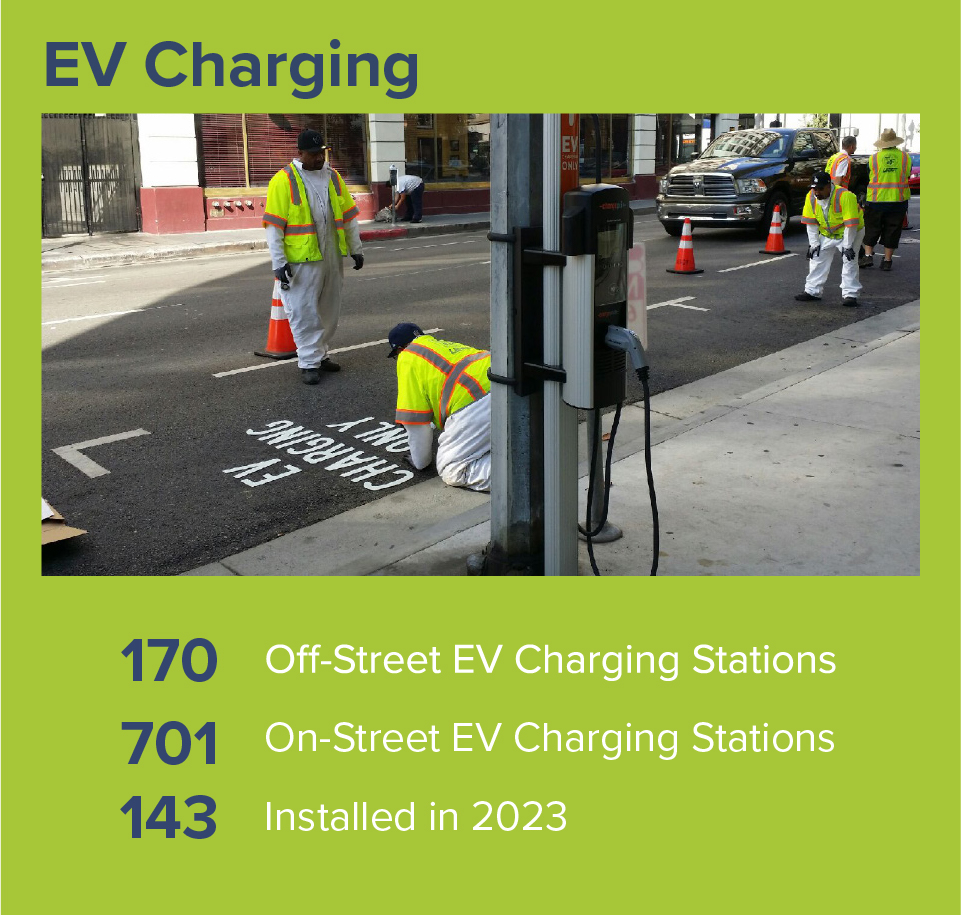 emissions-free transportation options must be easy to access, affordable for all, and safe to use. LADOT’s work expanding carbon-free shared vehicles programs and implementing bike lanes across the City are helping achieve this goal.
emissions-free transportation options must be easy to access, affordable for all, and safe to use. LADOT’s work expanding carbon-free shared vehicles programs and implementing bike lanes across the City are helping achieve this goal.
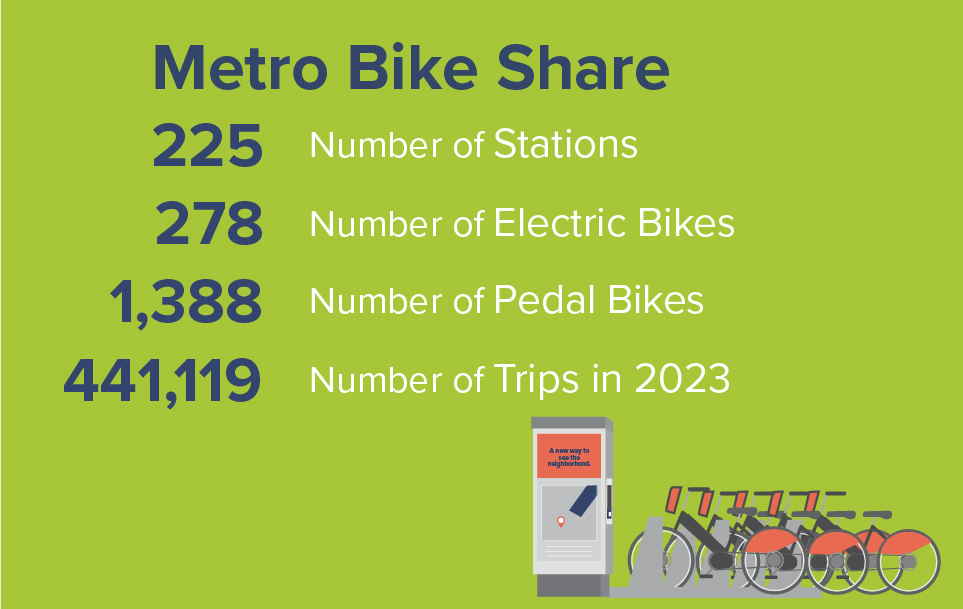
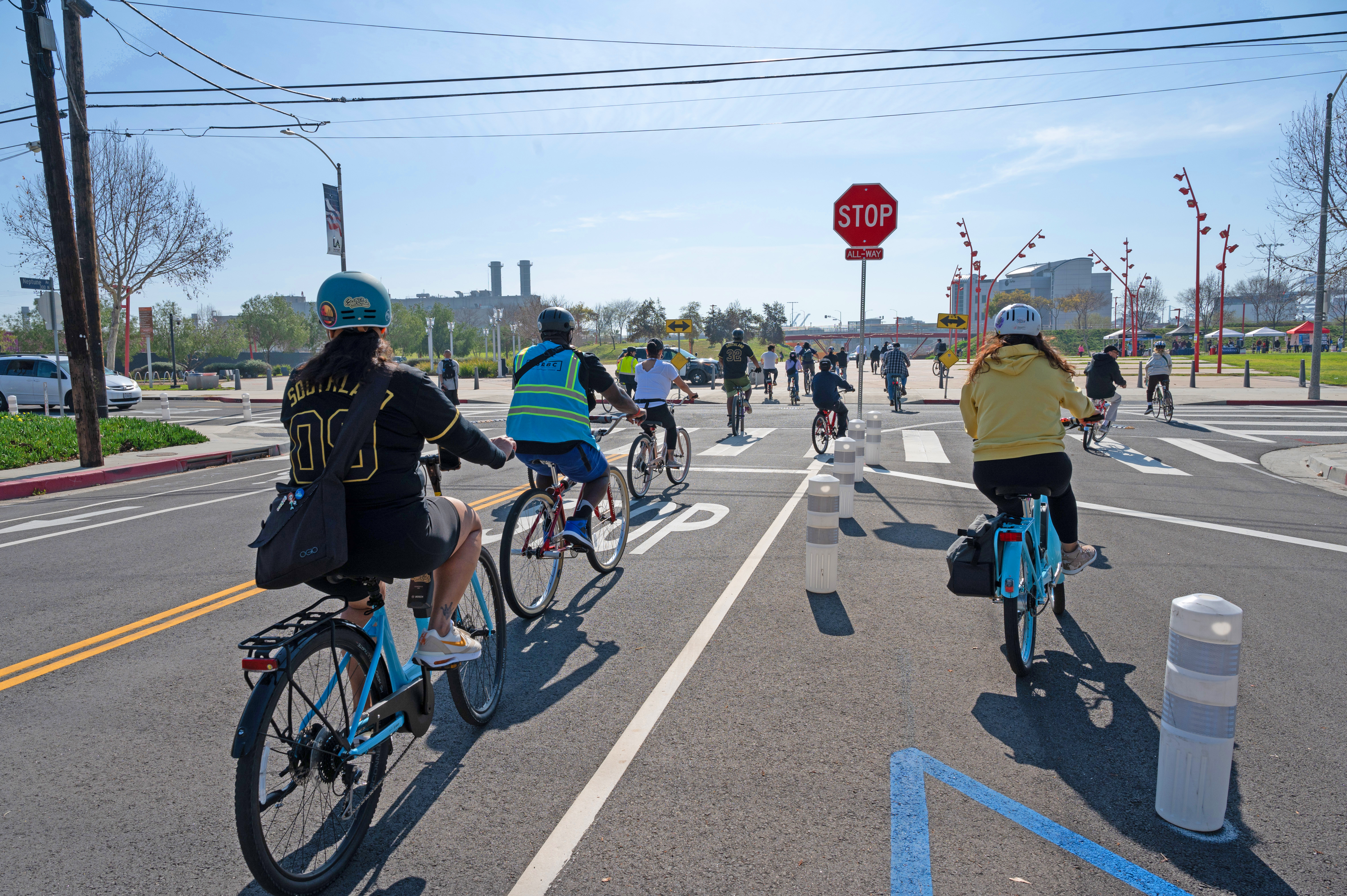
LADOT’s Community Collaboration
In order to build and maintain a transportation system that serves the needs of all Angelenos, LADOT believes planning and policy decisions should be made in partnership with the City’s communities. LADOT strives to both engage communities and give them the tools to advocate for their needs.
Throughout 2023, LADOT engaged the residents of Los Angeles with tabling events, workshops, and surveys that provided valuable knowledge and insight to their unique transportation needs. Feedback from the residents of Wilmington was crucial to LADOT’s redesign of Anaheim St to improve traffic safety and connectivity. This year, LADOT also partnered with People for Mobility Justice to lead a bike audit along Hollywood Blvd to learn first hand what improvements are most essential for the corridor’s upcoming redesign. Locals are the experts on their communities, and their feedback helps LADOT identify problems and prioritize solutions.
Additionally, LADOT’s partnership with community-based organizations and local leaders helps ensure that transportation projects are tailored to meet the needs of the community. In 2023, in collaboration with LA Walks, Las Promotoras, community members, advocates, and others, LADOT released the first-of-its-kind Bilingual Glossary Of Transportation Terms. This English-Spanish glossary of over 100 terms will help Spanish speakers advocate for their transportation needs.
LADOT also partners with community organizations to celebrate improvements and share information on how to use new infrastructure. This year, LADOT partnered with CicLAvia as well as local businesses, elected officials, and agency partners to celebrate the newly redesigned Venice Blvd. Guided bike tours gave participants the chance to experience the safety improvements in a friendly group environment.
By engaging with the diverse communities it serves, LADOT can better understand their needs and priorities, and create transportation policies that serve residents. Community engagement helps LADOT build stronger relationships with the people it serves and work collaboratively to create a more livable and vibrant City.
Excellent City Services
Emergency Response
LADOT Responds to I-10 Freeway Closure
On November 11, 2023, an emergency struck downtown Los Angeles. A rapidly-spreading fire erupted in a pallet yard on E 14th Street, engulfing the yard, multiple trailers, and a second pallet yard located beneath the I-10 freeway. Damage from the fire required the closure of the freeway between Alameda and the East LA interchange, an essential stretch of road that sees over 300,000 drivers each day. Initial reports indicated the freeway might be closed for weeks or even months as damage was assessed and repaired.
Following the closure, LADOT and the City of Los Angeles sprang into action, developing plans for the thousands of affected Angelenos. To help facilitate safe travel and support emergency response and recovery efforts, LADOT’s Special Traffic Operations team created an updated detour map each morning, deploying a minimum of 20 additional Traffic Officers to key intersections each day of the closure. Traffic Officers were also stationed at schools in the closure area to support safe drop off and pick up for students.
To address increased congestion during the morning and evening commutes, the City asked Angelenos to do whatever they could to reduce traffic, such as taking public transportation, telecommuting, carpooling, or using alternative routes. LADOT worked with Metro to make public transportation more accessible and efficient by adjusting signals on the Metro A and E lines, providing faster service to DTLA. LADOT also eliminated fares on Commuter Express buses, which provide long-range transit service from across the region.
For Angelenos who had to drive, LADOT crews worked quickly to install temporary striping and signal modifications in the area. Coordinating with Caltrans, LADOT created an additional turn lane in each direction at the intersection of Alameda and Olympic, as well as an additional turn lane for both on-ramps.
Thanks to crews who worked around the clock, the I-10 freeway was opened on November 20, far ahead of the initial estimates and in time for the Thanksgiving holiday. While this closure was one of the most severe transportation challenges in LA history, LADOT’s dedicated staff rose to the occasion to keep Los Angeles moving.
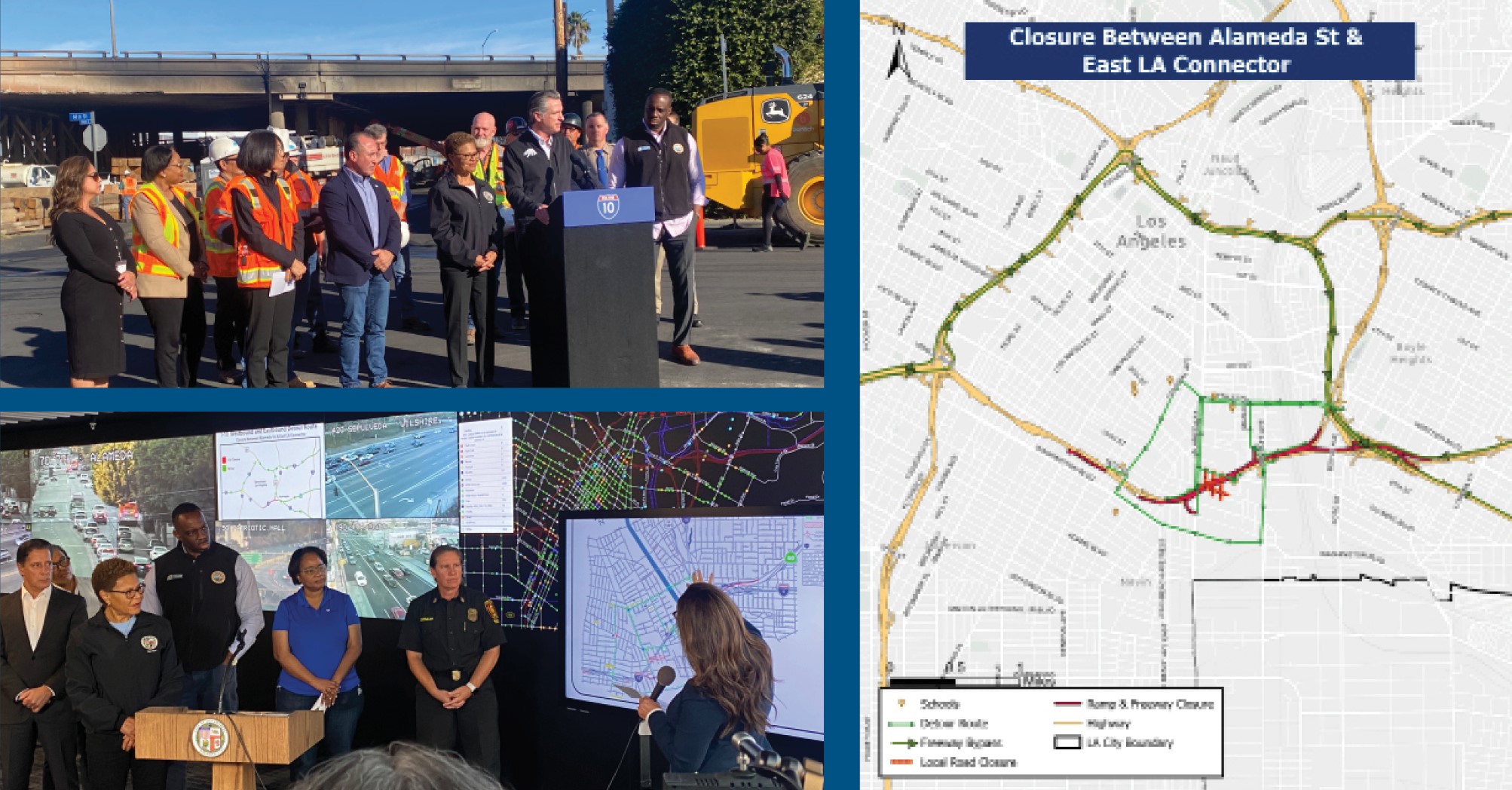
Weathering the Storms
In August, Los Angeles braced itself 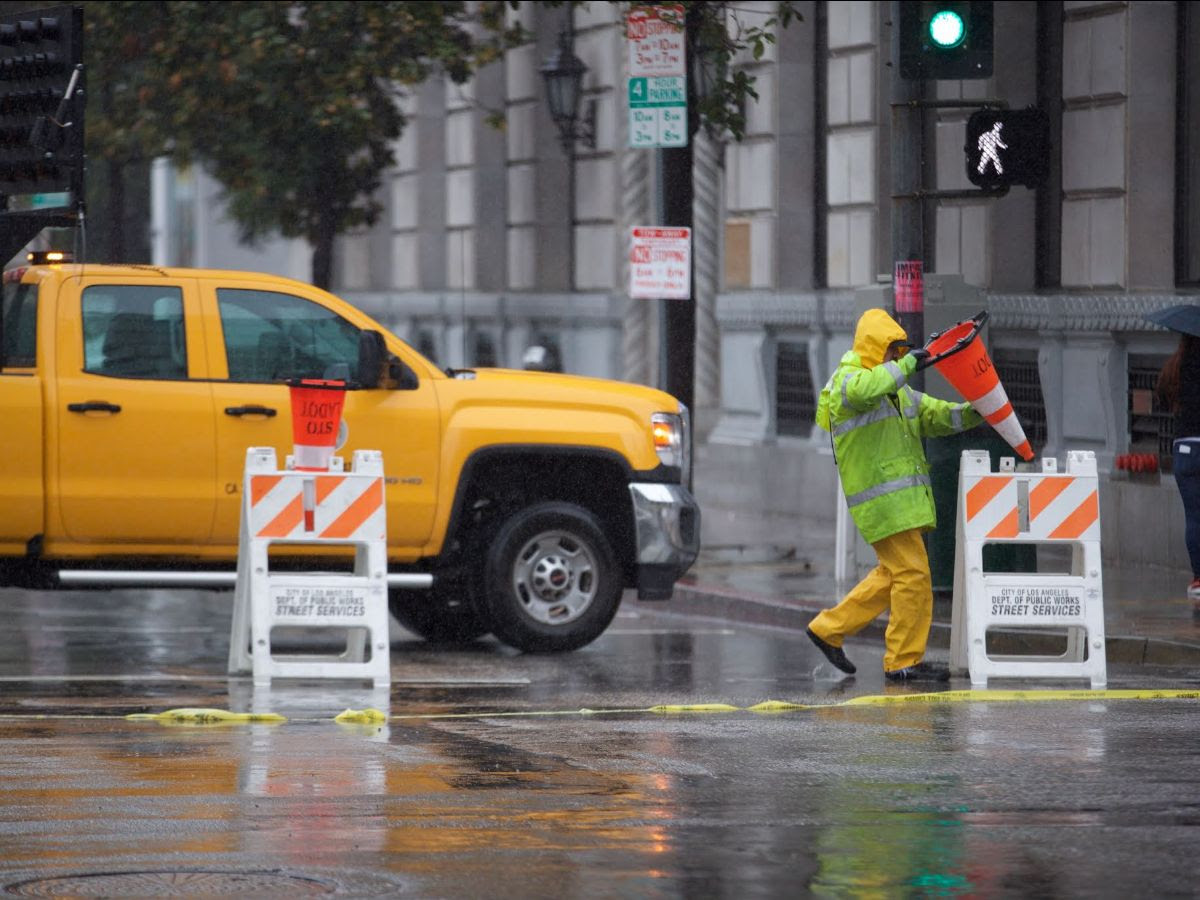 as a rare tropical storm made landfall in the City. Hurricane Hilary caused widespread damage with destruction to power lines and dangerous flooding. In the face of this crisis, it was all hands on deck as LADOT responded quickly and effectively to keep Angelenos safe and informed. Traffic Officers were deployed alongside the Special Traffic Operations team at critical locations throughout the City. ATSAC emergency signal repair crews worked to address multiple dark traffic signals. LADOT also provided transit for unhoused individuals needing transportation to shelters.
as a rare tropical storm made landfall in the City. Hurricane Hilary caused widespread damage with destruction to power lines and dangerous flooding. In the face of this crisis, it was all hands on deck as LADOT responded quickly and effectively to keep Angelenos safe and informed. Traffic Officers were deployed alongside the Special Traffic Operations team at critical locations throughout the City. ATSAC emergency signal repair crews worked to address multiple dark traffic signals. LADOT also provided transit for unhoused individuals needing transportation to shelters.
Hurricane Hilary was not the first bout of unprecedented weather Los Angeles faced in 2023. Winter storms in January pummeled the City, causing flooding and debris flow. Mudslides and extensive damage shut down roads like Mulholland Drive, which saw a partial closure for several weeks.
During every emergency storm event, LADOT works closely with other departments to keep the public informed and prepared for any potential disruptions. It is the swift response of LADOT’s employees that help ensure the safety of Los Angeles residents and visitors.

Supporting LA’s Response to the Crisis of Homelessness
Since In 2023, LADOT Traffic Officers and Tran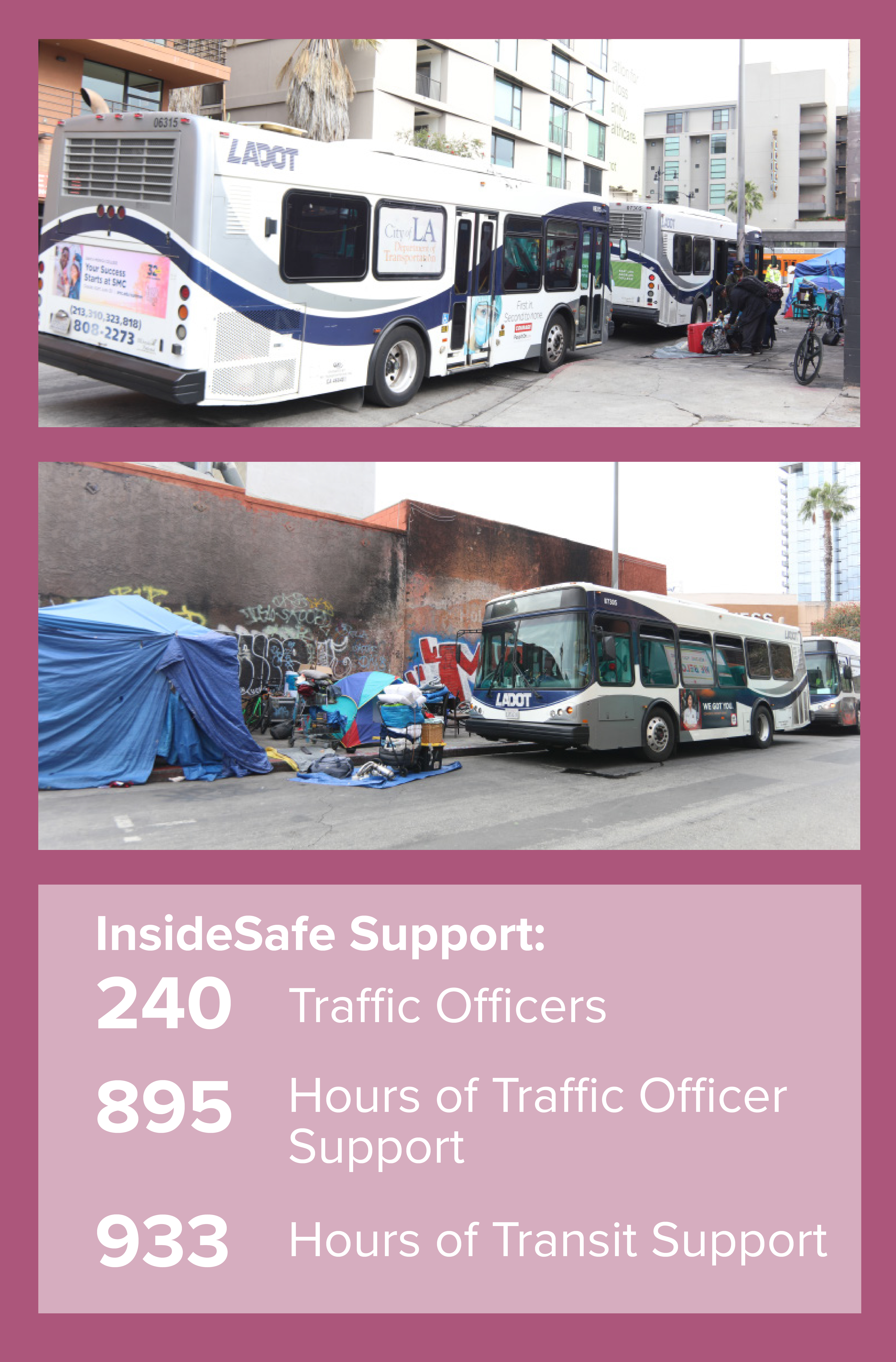 sit Operations took on a new role. Mayor Karen Bass’ second executive directive launched Inside Safe, an initiative that coordinates multi-agency operations to address encampments and vehicle dwelling hotspots by offering housing and services. Through these operations, LADOT Traffic Officers have supported outreach efforts to individuals living in RVs as well as road closures for cleanups. LADOT Transit Operations have provided transportation to bring individuals living in encampments to safe and sanitary housing options. Through this initiative, LADOT helped support the housing of 1,951 unhoused Angelenos and the removal of 503,460 lbs of waste from the public right-of-way over the course of the last year.
sit Operations took on a new role. Mayor Karen Bass’ second executive directive launched Inside Safe, an initiative that coordinates multi-agency operations to address encampments and vehicle dwelling hotspots by offering housing and services. Through these operations, LADOT Traffic Officers have supported outreach efforts to individuals living in RVs as well as road closures for cleanups. LADOT Transit Operations have provided transportation to bring individuals living in encampments to safe and sanitary housing options. Through this initiative, LADOT helped support the housing of 1,951 unhoused Angelenos and the removal of 503,460 lbs of waste from the public right-of-way over the course of the last year.

Transitioning LA Al Fresco to a Permanent Program
In 2023, LADOT transitioned its LA 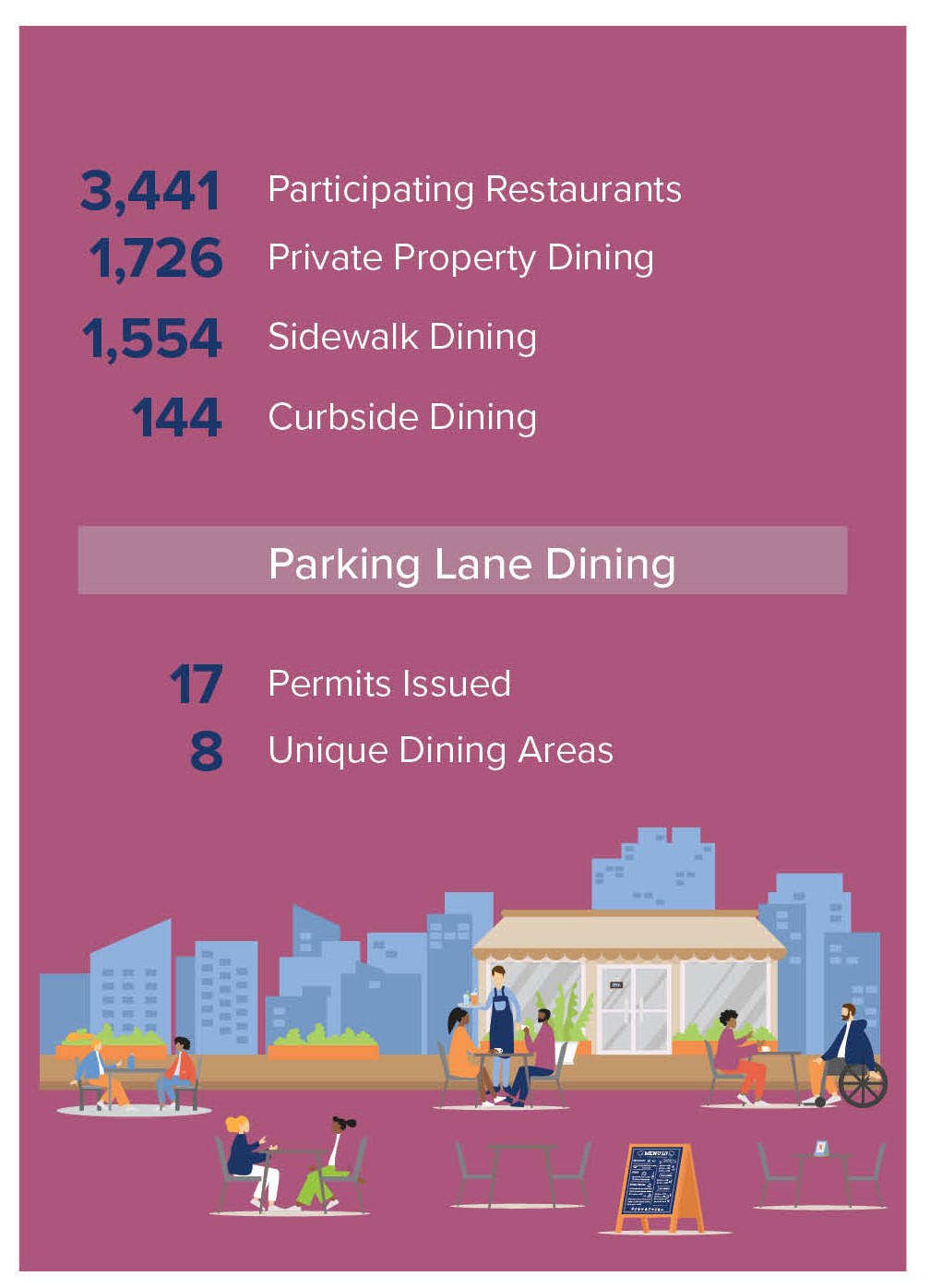 Al Fresco program from temporary to permanent. Created as a response to the COVID-19 pandemic in 2020, the Al Fresco program streamlined the process for local restaurants to expand their operations to dining on streets, sidewalks, and private property near their establishments. Prior to this program, outdoor dining took months to approve and was much more costly. The Al Fresco program was extremely successful, with over 3,000 businesses participating, and LADOT began to transition the program from temporary to permanent.
Al Fresco program from temporary to permanent. Created as a response to the COVID-19 pandemic in 2020, the Al Fresco program streamlined the process for local restaurants to expand their operations to dining on streets, sidewalks, and private property near their establishments. Prior to this program, outdoor dining took months to approve and was much more costly. The Al Fresco program was extremely successful, with over 3,000 businesses participating, and LADOT began to transition the program from temporary to permanent.
In September 2023, LADOT closed the temporary application process and opened the permanent process on February 1, 2024. Businesses must complete the application in its entirety by July 31, 2024 and are encouraged to apply early.
The LA Al Fresco program has been a lifeline to businesses. According to a survey of participants, nearly 80% stated that they would not have been able to stay in business without the flexibility and expanded dining options.
New Tour Bus Ordinance Adopted
 From the Hollywood Walk of Fame to the iconic Venice beach, Los Angeles’ world-famous landmarks attract millions of tourists every year. Tourists bring significant economic benefits to the City, but it can be a challenge for City departments to balance the needs of residents with the needs of tourism. In 2023, LADOT worked with the Los Angeles City Council to establish a new Tour Bus Ordinance to ensure that residents and visitors alike can enjoy this beautiful city.
From the Hollywood Walk of Fame to the iconic Venice beach, Los Angeles’ world-famous landmarks attract millions of tourists every year. Tourists bring significant economic benefits to the City, but it can be a challenge for City departments to balance the needs of residents with the needs of tourism. In 2023, LADOT worked with the Los Angeles City Council to establish a new Tour Bus Ordinance to ensure that residents and visitors alike can enjoy this beautiful city.
Tour buses are a popular way for visitors to see Los Angeles. Guided tours are comfortable and informative, and the rich variety of operators mean tourists can choose exactly the experience they want.
However, tour buses can pose a hazard to both tourists and residents. Certain streets are not built to accommodate a high volume of large, heavy vehicles. Tour buses also stop frequently for customers to view sites, load and unload, or take pictures. These actions can block traffic on narrow and winding roadways where it is unsafe for drivers to pass.
At the direction of the City Council, LADOT developed evaluation criteria to determine where it was necessary to restrict tour bus operations, taking into account tour bus volumes, roadway conditions, and crash patterns. LADOT used this criteria to study all street segments requested by the local Neighborhood Council or Council Office, ultimately recommending a restriction on tour bus parking on 39 street segments and of tour buses entirely on 24 street segments.
The Los Angeles City Council approved the Tour Bus Ordinance in the fall of 2023. LADOT is currently in the process of communicating the changes to tour bus companies as well as printing and posting signage to inform operators of restrictions in effect. This ordinance will help ensure safe and livable neighborhoods for residents while maintaining LA’s thriving tourism industry.
The Event Economy
Los Angeles is a happening city. From awards shows to major sports events, moving LA forward requires significant mobilization of Traffic Officers and Special Traffic Operations Engineers to plan and execute the safe movement of thousands of people through road closures and detours during special events. Thanks to the efforts of LADOT staff, events like the Taste of Soul Festival, the LA Marathon, and the Academy Awards collectively generate billions of dollars in economic activity while minimizing disruption of the continued movement of people and goods around Los Angeles.

Expanding Housing Availability for Angelenos Experiencing Homelessness
LADOT plays an important role in the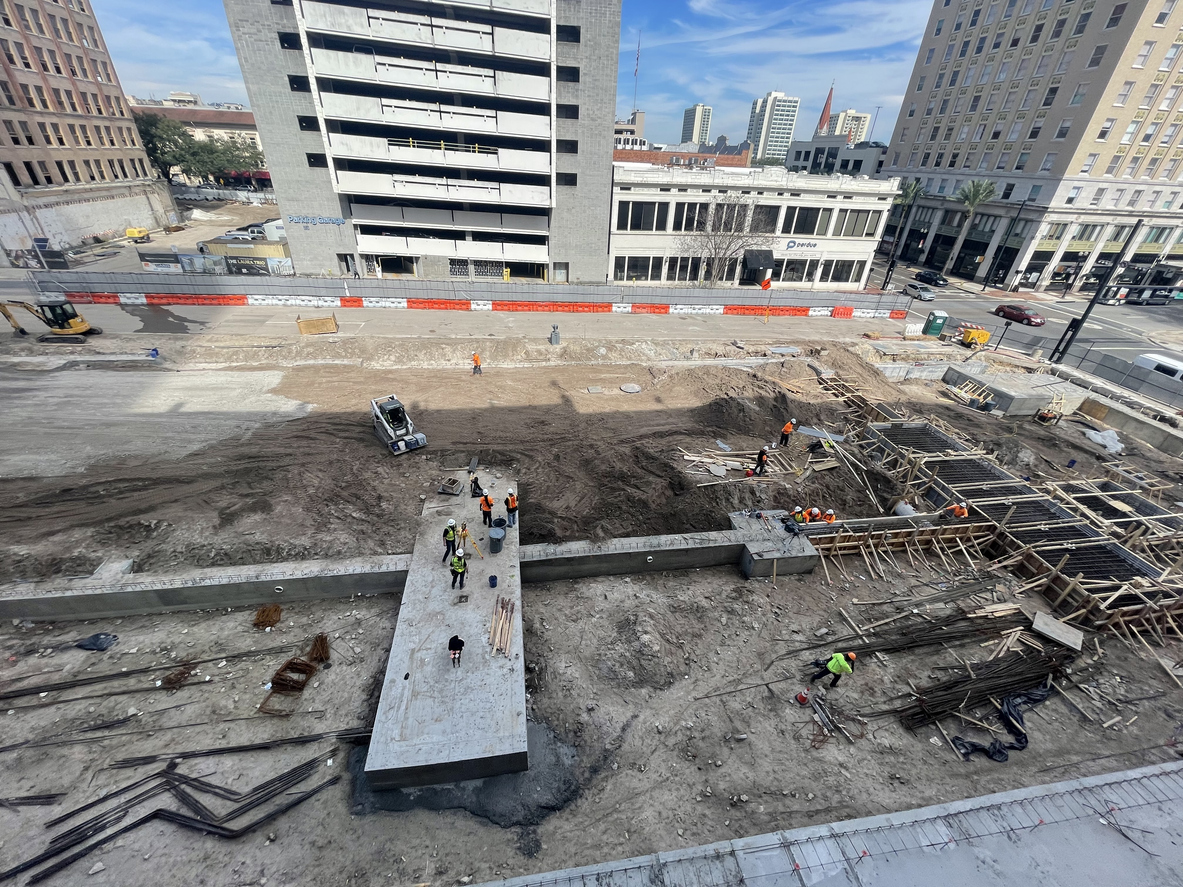 review and approval process for new developments and construction projects in the City of Los Angeles. This includes the examination of traffic impacts, accessibility, and verifying safe ingress and egress for new buildings.
review and approval process for new developments and construction projects in the City of Los Angeles. This includes the examination of traffic impacts, accessibility, and verifying safe ingress and egress for new buildings.
In order to support the economic growth of our City, it is critical that LADOT performs these reviews in a timely and cost-effective manner. Following Mayor Karen Bass’ first executive directive, LADOT has further accelerated a key component of this process: review and approval for affordable housing.
By the end of 2023, LADOT had processed 60 building permits for affordable housing developments and a total of 1252 building permits for projects of all kinds with an average turnaround time of four days per project. LADOT’s development review team will continue this record setting pace to ensure our City’s growth.
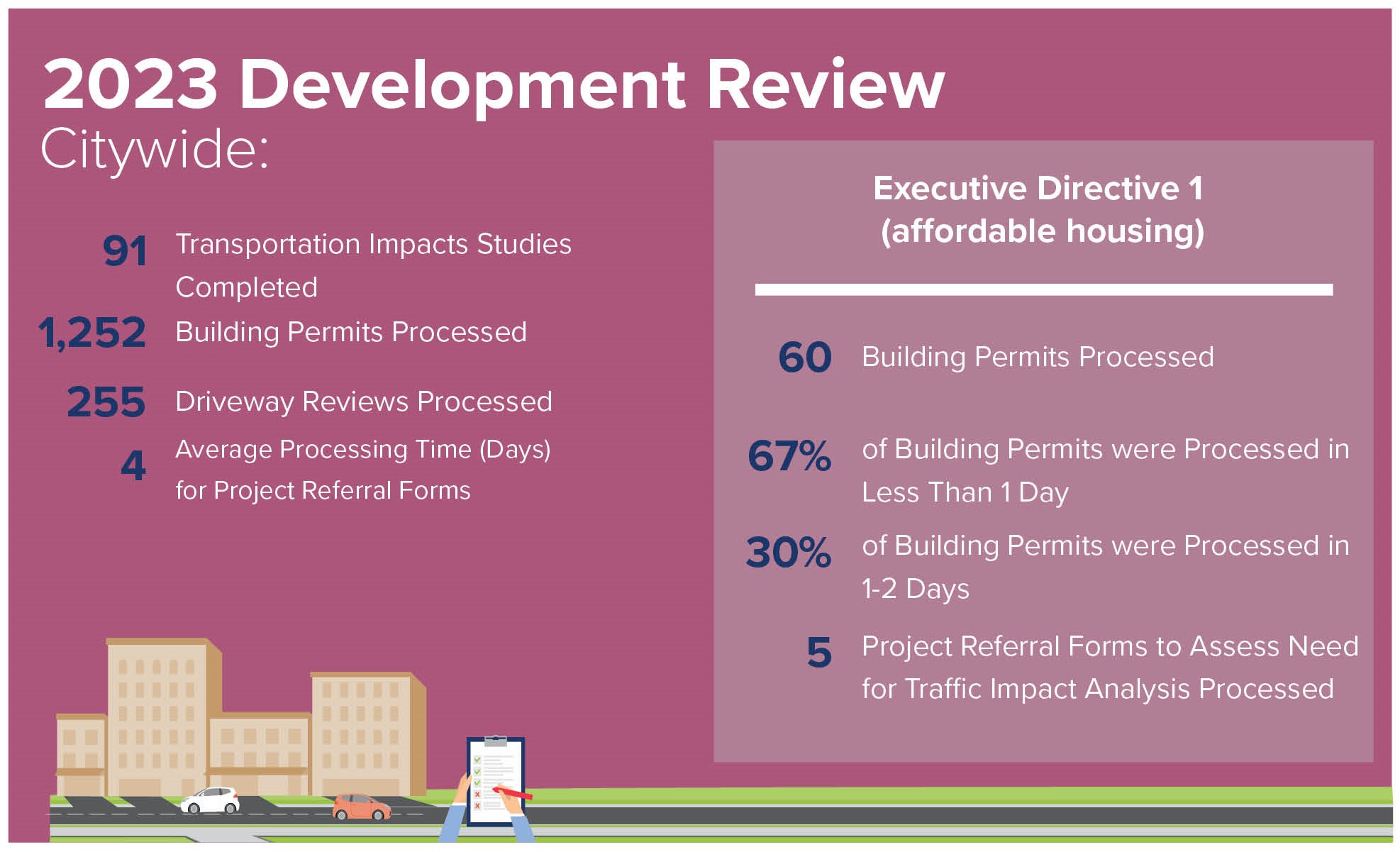
Coding the Curb for a Vibrant Economic Future
The last decade has seen a transformation 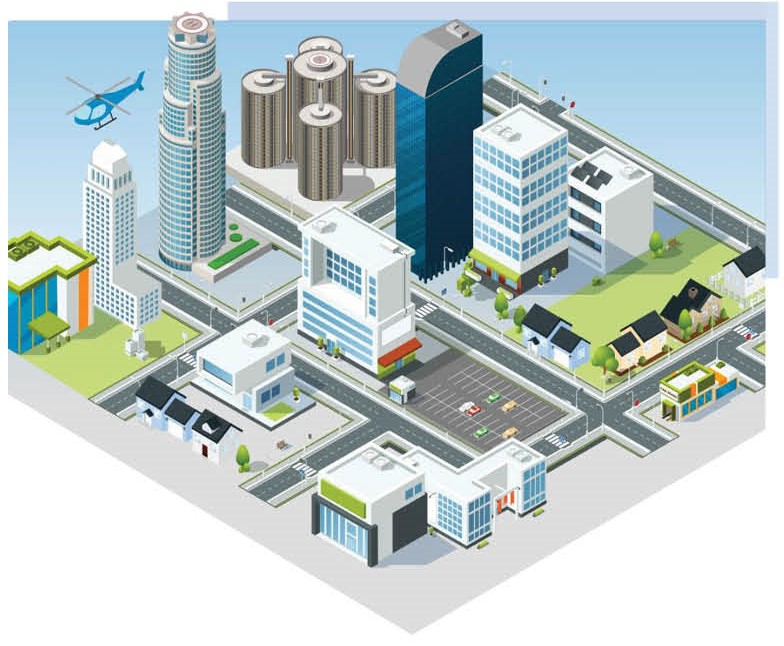 of City streets, with rideshare and meal delivery drivers now competing for valuable curb space alongside buses, street parking, food trucks, and more. This increased competition causes stress and confusion for drivers as they navigate posted signs, wasted emissions as vehicles are forced to circle the block, and safety concerns when drivers block traffic or bike lanes.
of City streets, with rideshare and meal delivery drivers now competing for valuable curb space alongside buses, street parking, food trucks, and more. This increased competition causes stress and confusion for drivers as they navigate posted signs, wasted emissions as vehicles are forced to circle the block, and safety concerns when drivers block traffic or bike lanes.
In March of 2023, LADOT undertook a major step in efforts to modernize the City’s curb space. The US Depart of Transportation (USDOT), through the Strengthening Mobility and Revolutionizing Transportation (SMART) grant program, awarded LADOT a $2 million grant to kickstart the DTLA Code The Curb pilot.
Code The Curb will create a digital inventory of curbs, signs, and markings across the DTLA area. This comprehensive database will enable the City to develop innovative tools for managing this resource, guiding residents and vendors more efficiently and safely through our streets and sidewalks.
With this grant, LADOT joins a partnership of Open Mobility Foundation (OMF) member cities committed to tackling a common problem with shared technology. As the Code the Curb pilot progresses, LADOT will be able to connect with these peer cities, sharing experiences, lessons, and insights to further enhance curb space management.
LADOT Completes MyLA311 Integration
Mayor Karen Bass’ Executive Directive 5 tasks City departments with improving the accessibility and responsiveness of constituent services. In June of 2023, LADOT completed the integration of all of its services into the City’s 311 system, MyLA311, making it easier than ever for the public to submit service requests like sign replacements or traffic signal modifications.
The process of combining all of the City’s services into one system began in the fall of 2020. LADOT first conducted an inventory of service requests to determine the necessary categories, then compiled Knowledge Articles to provide the public with an understanding of how LADOT processes these requests. During this time, LADOT’s district offices worked to clear the back log of service requests from the COVID-19 pandemic.
The completed integration with MyLA311 enables LADOT to organize all of its services in a way that is easily accessible to the public, allowing for better tracking and fulfillment of requests.
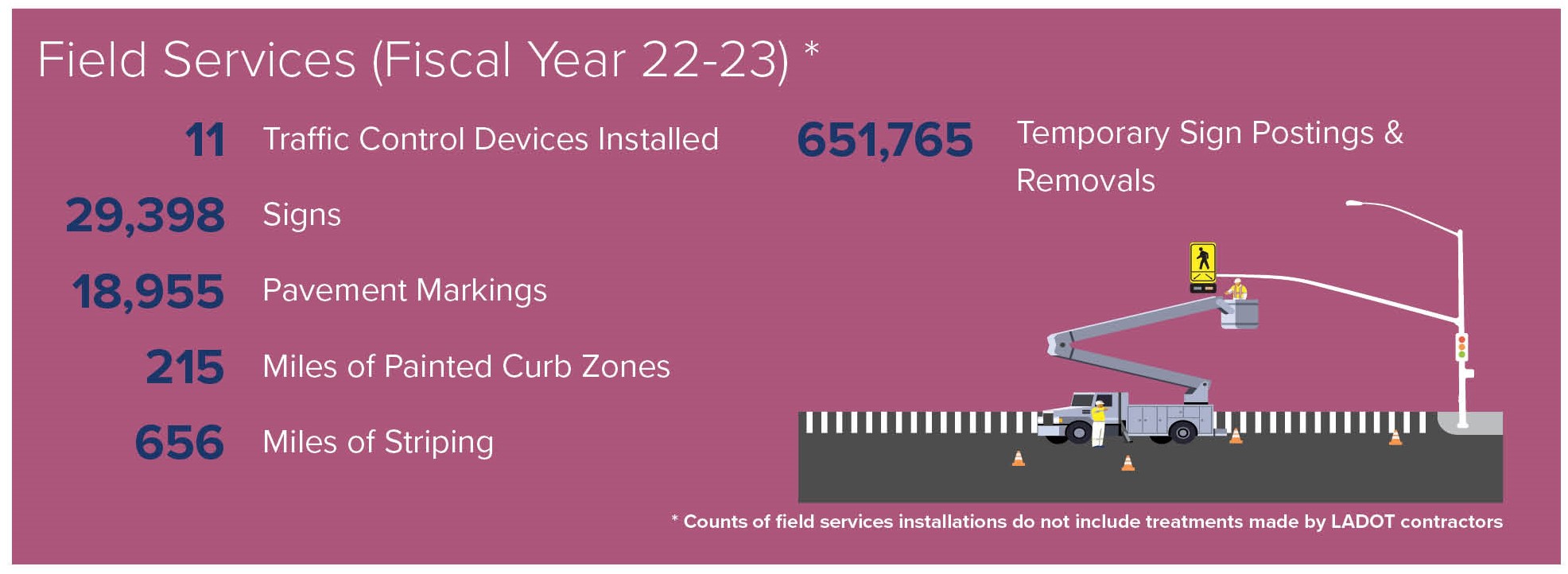
Equity & Mobility
Mobility Wallet Supports Transportation Access
South LA is home to a high percentage of 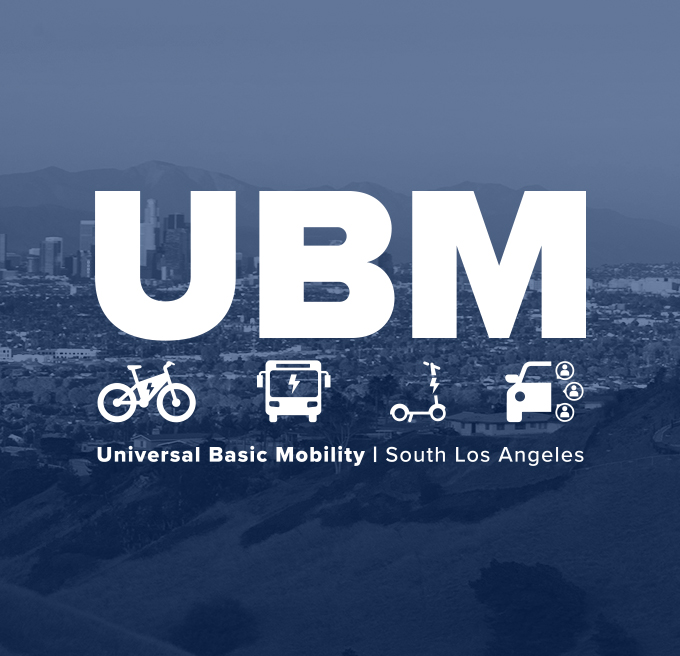 households below the poverty line, many of which either do not own a vehicle or only have one car at home. The South LA Universal Basic Mobility (UBM) Pilot, launched in 2022 with a grant from the California Air Resources Board (CARB), invests in community-driven transportation solutions for this historically underserved neighborhood. This year, LADOT continued to expand the UBM Pilot by partnering with Metro to launch the Mobility Wallet pilot program.
households below the poverty line, many of which either do not own a vehicle or only have one car at home. The South LA Universal Basic Mobility (UBM) Pilot, launched in 2022 with a grant from the California Air Resources Board (CARB), invests in community-driven transportation solutions for this historically underserved neighborhood. This year, LADOT continued to expand the UBM Pilot by partnering with Metro to launch the Mobility Wallet pilot program.
This innovative program aims to make transportation more accessible and equitable for South LA residents. 1000 eligible participants were chosen to receive $150 a month to spend on 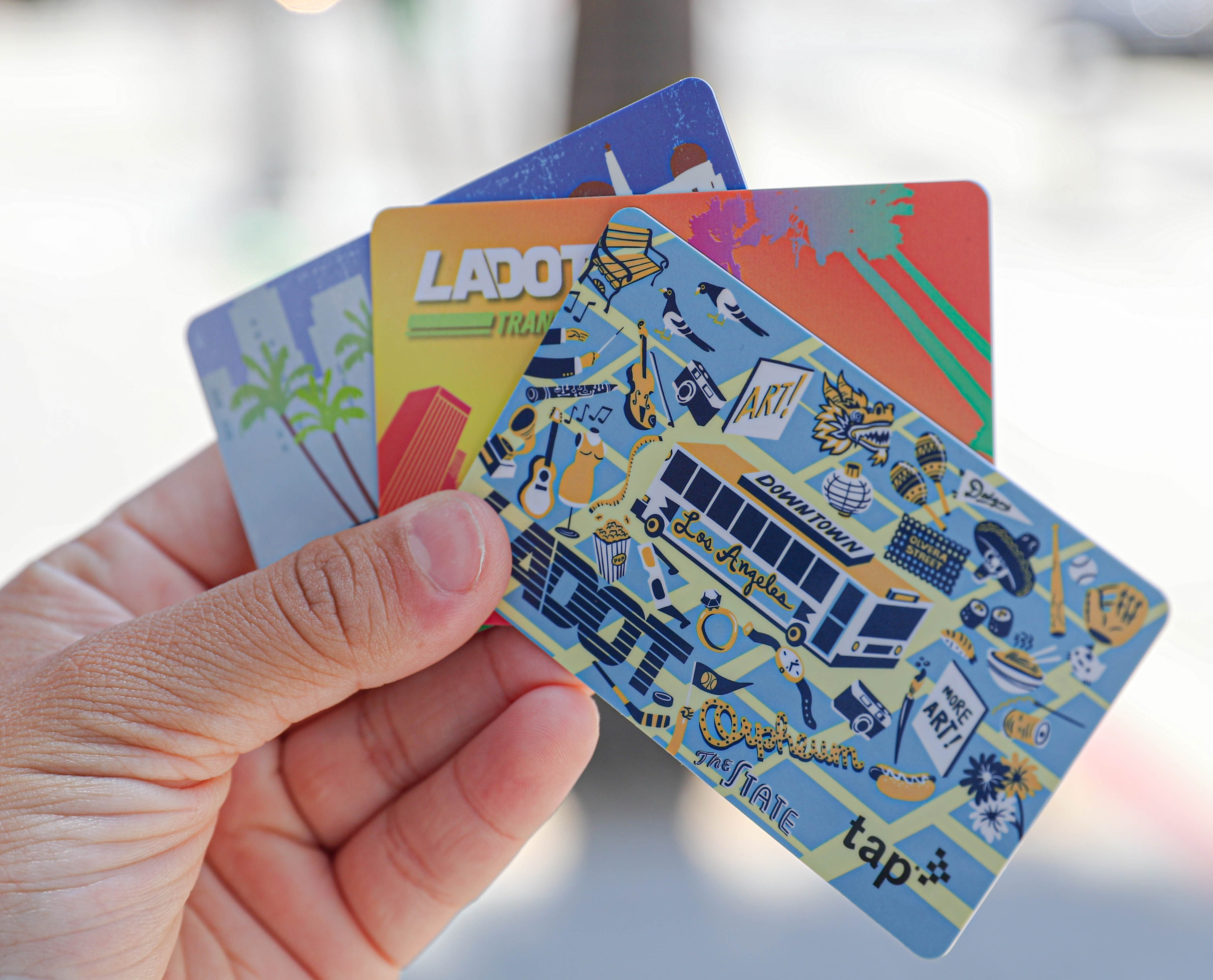 mobility in the form of a prepaid card. New funds are loaded automatically, and any unused balance rolls over to the next month. Unlike other subsidized transit programs, Mobility Wallet participants are empowered to choose the best solution for their needs from a menu of transportation options. Funds can be spent on trains, buses, rideshare, bike share, taxis, and electric scooters. Any money remaining at the end of the program may be used to purchase larger ticket items, such as a bike or scooter.
mobility in the form of a prepaid card. New funds are loaded automatically, and any unused balance rolls over to the next month. Unlike other subsidized transit programs, Mobility Wallet participants are empowered to choose the best solution for their needs from a menu of transportation options. Funds can be spent on trains, buses, rideshare, bike share, taxis, and electric scooters. Any money remaining at the end of the program may be used to purchase larger ticket items, such as a bike or scooter.
The Mobility Wallet pilot program both promotes sustainable trips and removes barriers to transportation that make it more difficult to access health resources and economic opportunities. The pilot will expand in 2024 to an additional 1000 participants, making it the largest program of its kind in the nation.
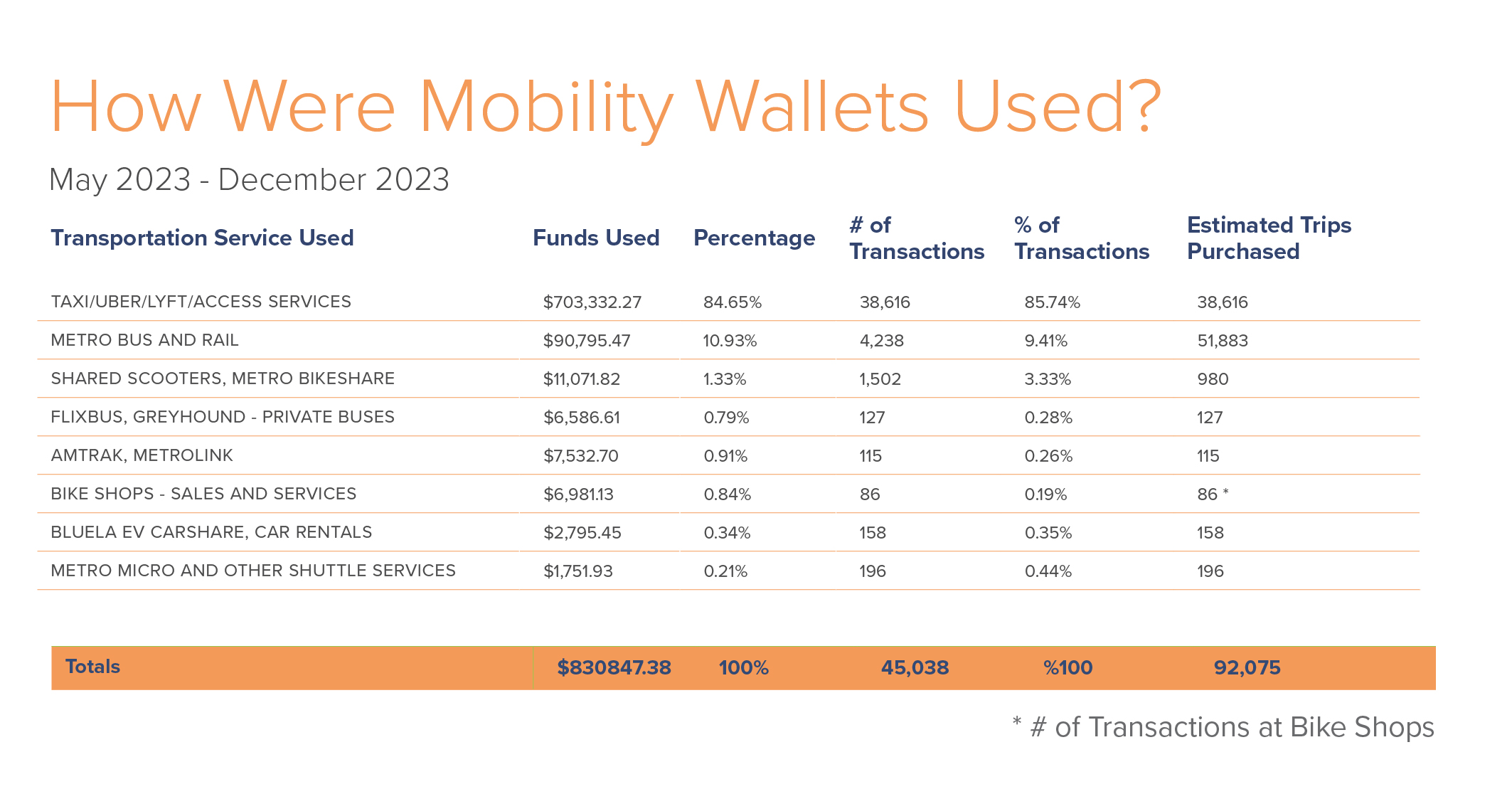

Training for Transportation Jobs of the Future
Along with the LADOT Universal Basic Mobility pilot, the California Air Resources Board Sustainable Transportation Equity Project (STEP) grant provided partial funding for an electric vehicle maintenance training program with Los Angeles Trade-Technical College. The EV maintenance training program both prepares community members for employment and ensures the City is ready for an electric and sustainable transportation future. Students complete the program with industry-recognized certifications to help them succeed in the green economy.
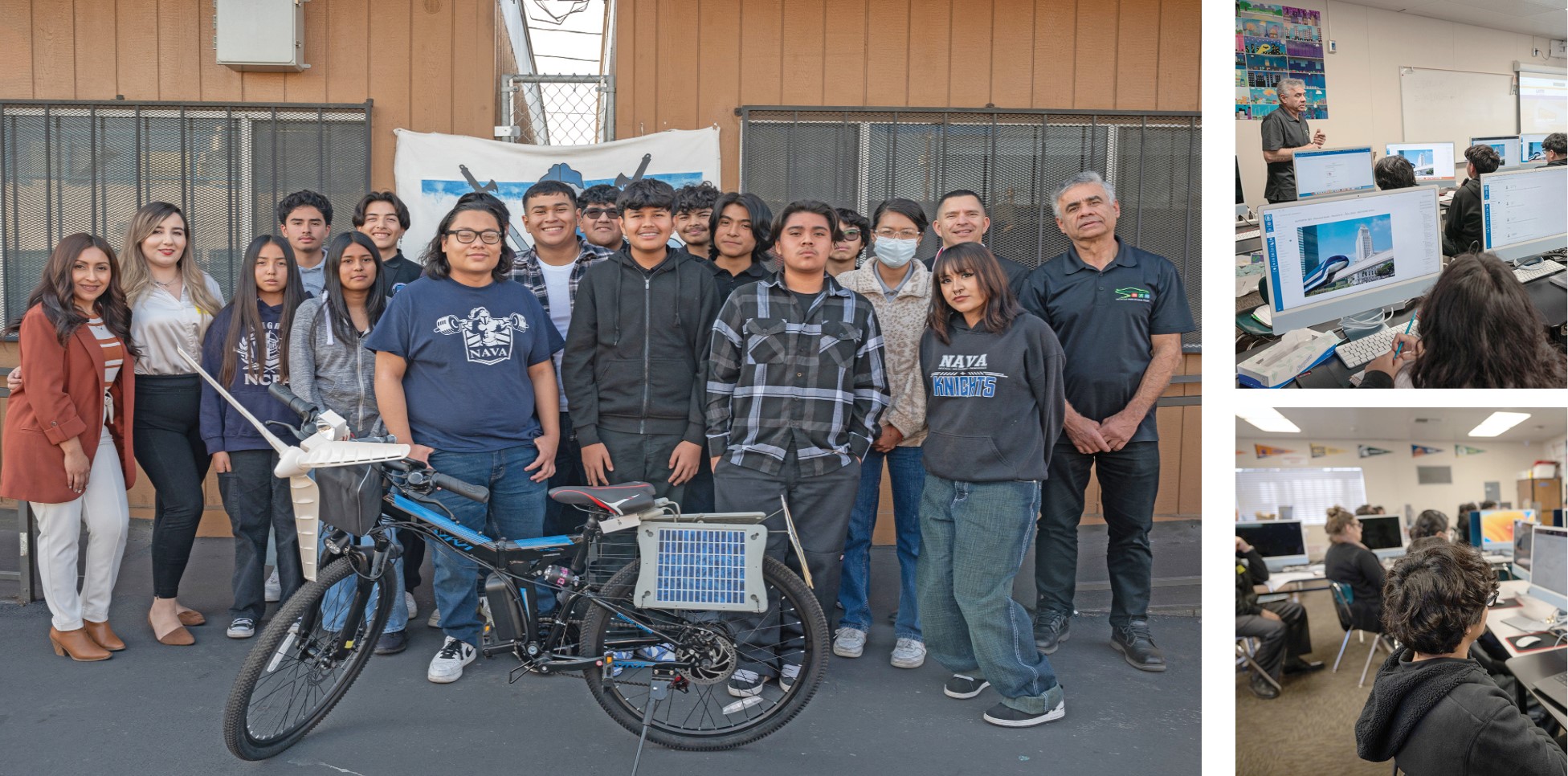
Ambassadors for Climate Justice
With the support of the Universal Basic Mobility pilot, LADOT launched the Youth Ambassador program at Nava College Preparatory Academy which provides high school students and recent graduates with an overview of sustainable mobility. Students learn the basic terminology of electric vehicles and other sustainable transportation options, as well as gain hands-on experience with electrical components. The Youth Ambassador program empowers young Angelenos with the knowledge to make environmentally conscious choices and become agents of change in their communities.
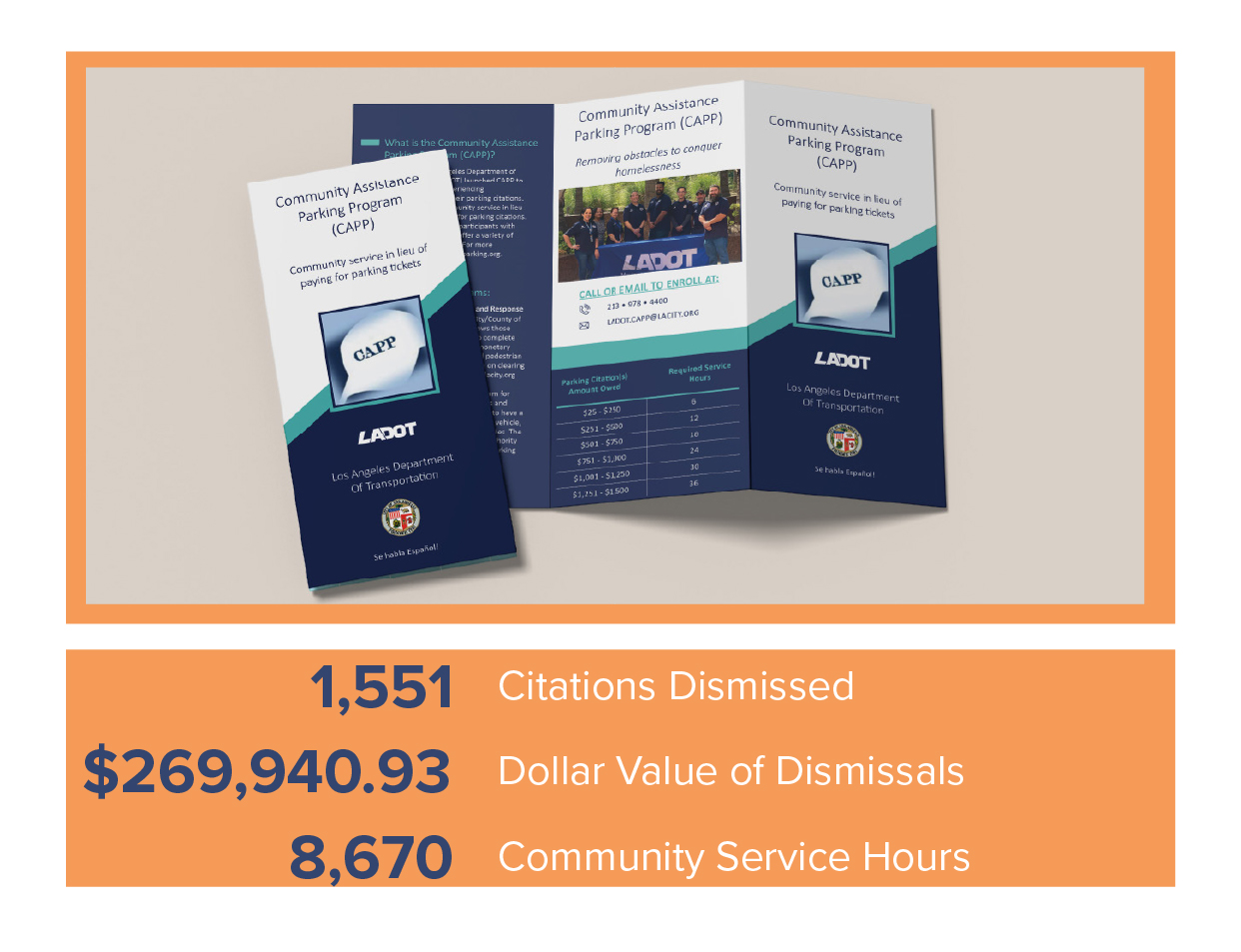
Helping Individuals Experiencing Homelessness Pay Parking Citations
LADOT recognizes that, for some Angelenos, parking citations can not only be an inconvenience but a financial burden. For those experiencing homelessness, that burden can be even more significant. The Community Assistance Parking Program (CAPP) helps these individuals pay off unpaid or open parking citations through community service. Eligible participants are able to select a form of service, such as kitchen work, garden work, administrative work, and more. The CAPP program has helped dismiss thousands of citations while simultaneously working to help those experiencing homelessness integrate back into the community.
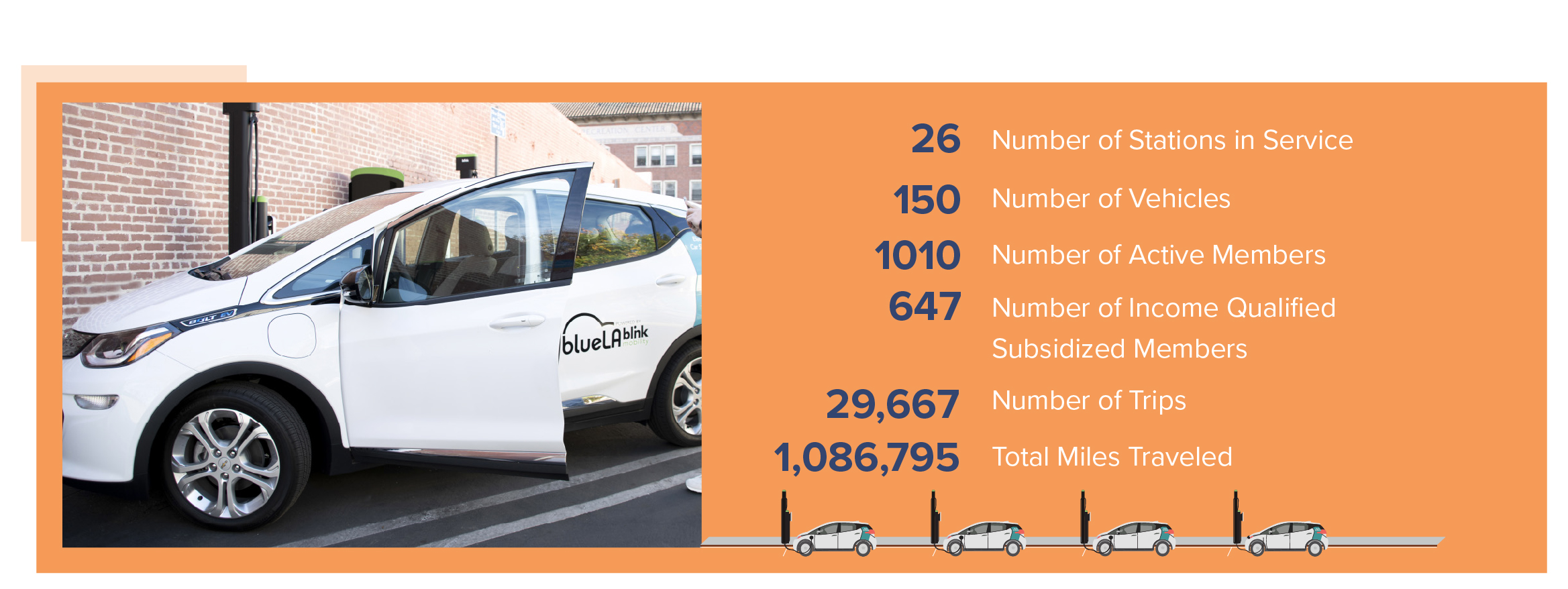
BlueLA Helps Low-Income Angelenos Meet Transportation Needs
LA is home to one of the largest all-electric car-sharing services in California, BlueLA powered by Blink Mobility. BlueLA launched in 2018 following a grant from the California Air Resources Board (CARB) through California Climate Investments, with the goal of offering affordable and clean transportation alternatives to Angelenos in disadvantaged or underserved communities.
BlueLA is available to anyone who enrolls in the program. However, by providing subsidized service to qualified, low-income individuals, the program provides a vital service to families who do not have access to a car. While public transit services are essential, BlueLA supports trips that are not easily made using transit. For example, many users report relying on the service to perform essential errands like going to a medical appointment or making a job interview.
Due to the high demand for this service, the City and BlinkMobility added an additional 50 new electric cars to the BlueLA fleet last year to ensure that a sufficient number of vehicles are available to users when needed. To improve ease of access, a new user-friendly mobile app was launched in September of 2023.
Expansion will continue in 2024 with the goal of adding additional stations and vehicles in new neighborhoods, including underserved areas like South LA and Boyle Heights.
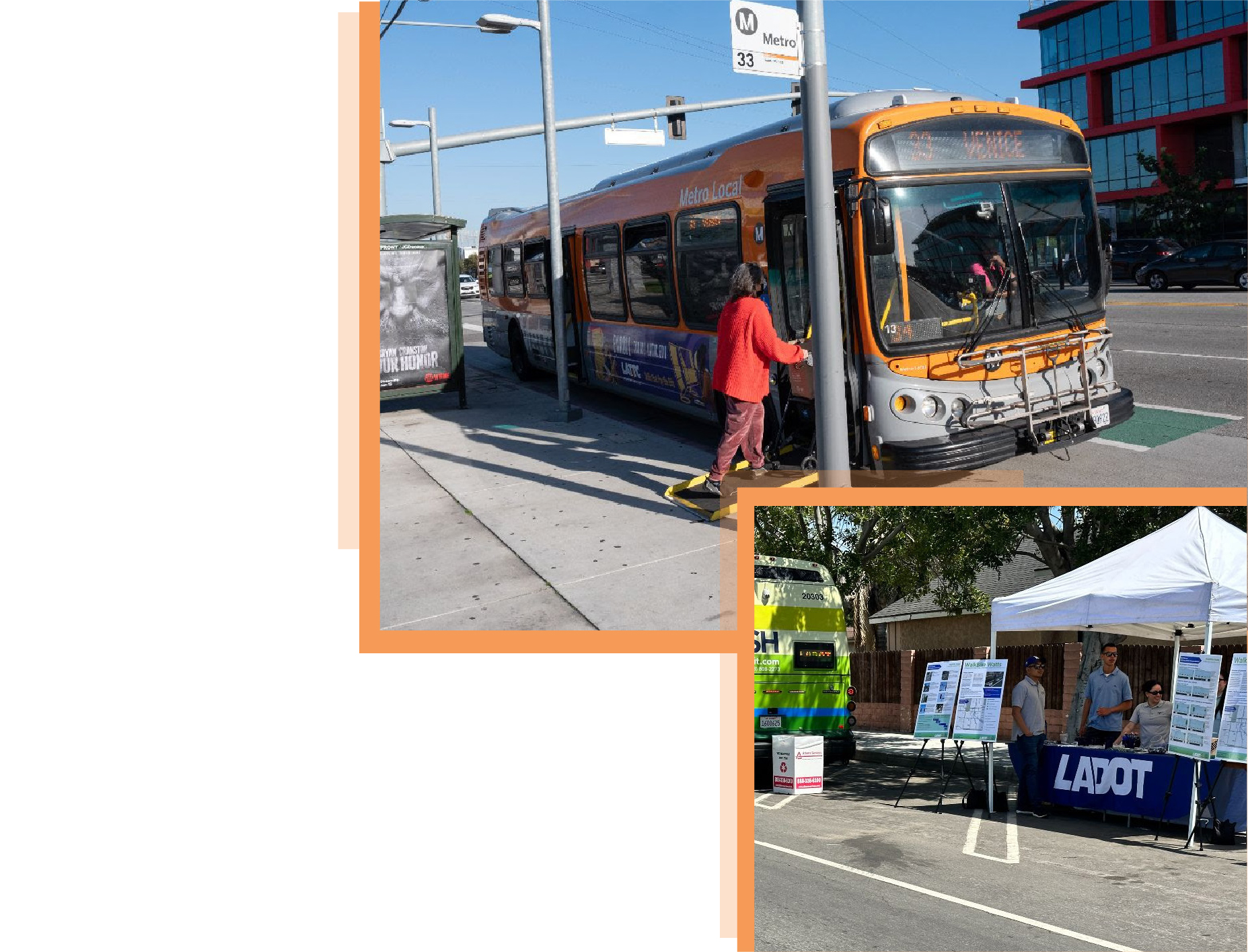
Alternative Models for Traffic Enforcement
Civil unrest sparked by the murder of George Floyd, a Black man, by Minneapolis police in 2020 brought the issue of police brutality against African Americans to the forefront of the national conversation. In response, the City of Los Angeles has been grappling with how to address systemic racism and rethinking the role of law enforcement in transportation. As part of this conversation, in 2023 LADOT assisted with the submission of the Traffic Enforcement Alternatives Project Report, which provides recommendations for the City and City Council on potential changes to the armed enforcement model.
In February 2021, City Council directed LADOT with assistance of the City Administrative Officer, Chief Legislative Analyst, the Los Angeles Police Department (LAPD), and the City Attorney to conduct a study that evaluates opportunities for unarmed traffic enforcement in the City. Once LADOT selected a research consultant team and created an Advisory Task Force, the project began in March 2022. The 13 member task force was made up of individuals with both personal and professional experience relevant to traffic stops and police enforcement. The task force met approximately once a month from June 2022 to September 2023, discussing topics of concern, receiving updates from the research consultant team, and reviewing proposed recommendations.
Meanwhile, the research consultant team provided quantitative and qualitative analysis to support the project, working with data from both LADOT and LAPD to assess trends in traffic stops and traffic safety infrastructure investments. Community focus groups, expert interviews, and legal research were also conducted and analyzed for overlap with quantitative findings.
The final report included recommendations to prioritize road features that naturally slow traffic, prevent drivers from breaking traffic rules, and limit law enforcement’s ability to stop motorist for minor violations; implement alternative traffic fine and fee models; improve local officer accountability mechanisms to restore community trust in law enforcement; and deploy unarmed civilians and care-centered teams to address traffic safety issues.
City Council will evaluate these recommendations going forward into 2024 as the City continues the important work of creating a safe and equitable Los Angeles.
Open Streets Expand Possibilities for Los Angeles Neighborhoods
The streets of Los Angeles are usually thought of as a means to an end, a way for people to move from point A to point B. Open streets events prove that City streets can be a destination in and of themselves. With the support of LADOT Traffic Officers, Engineers, and Special Traffic Operations teams, our engagement teams work alongside neighborhood organizations to transform streets into vibrant spaces for Angelenos to gather and enjoy walking, biking, music, food trucks, supporting local businesses, and above all else, community.
LADOT partnered with several organizations in 2023 to organize more open streets events than ever before. Together, LADOT and these partner organizations are reimagining how LA streets are used as part of LADOT’s mission to create streets that are safe and sustainable in support of a thriving City.
Play Streets
Our LA Play Streets program unleashes the fun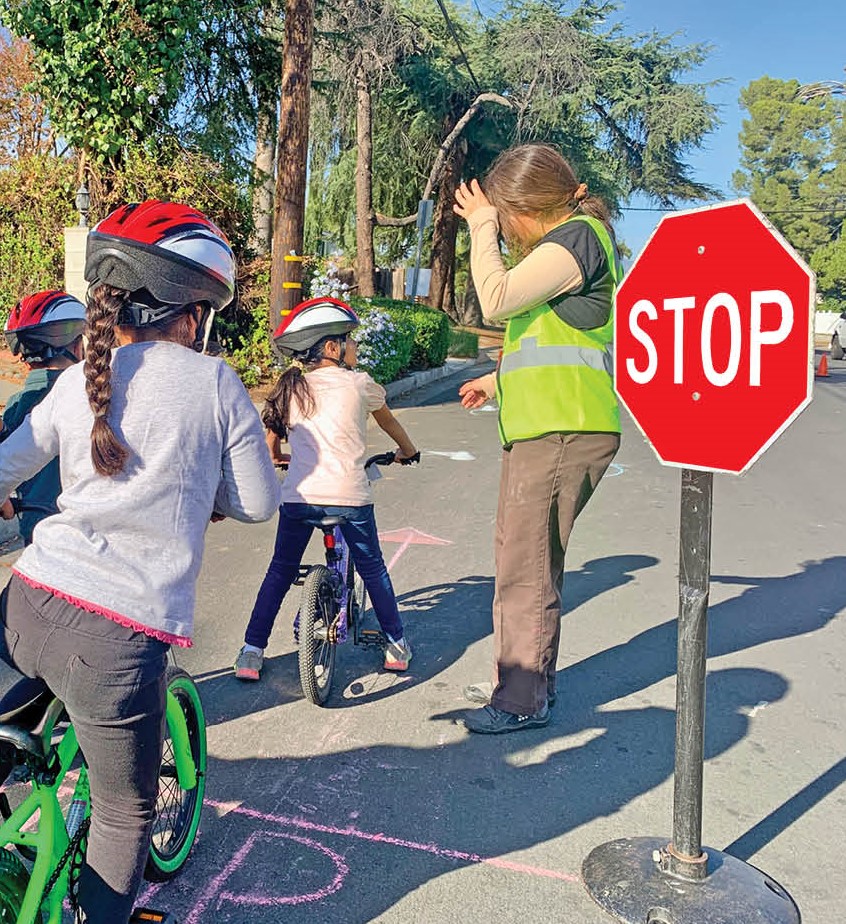 by turning a neighborhood block into a lively play zone for kids of all ages. Only 30% of Angelenos live within walking distance of a park. LADOT’s Play Streets program helps address this inequity by working closely with community-based organizations to identify areas that may lack safe and free public spaces.
by turning a neighborhood block into a lively play zone for kids of all ages. Only 30% of Angelenos live within walking distance of a park. LADOT’s Play Streets program helps address this inequity by working closely with community-based organizations to identify areas that may lack safe and free public spaces.
Following the lead of the community partners, LADOT closes the street to vehicle traffic and opens it into a safe area for play, relaxation, conversation, and support. Along with dancing, eating, and playing, residents are able to connect with various City resources, ranging from health to social services. .
In 2023, LADOT’s Play Streets team brought the program to the communities of North Hills, Green Meadows, North Hollywood, Rampart Village/Historic Filipinotown, and South LA..
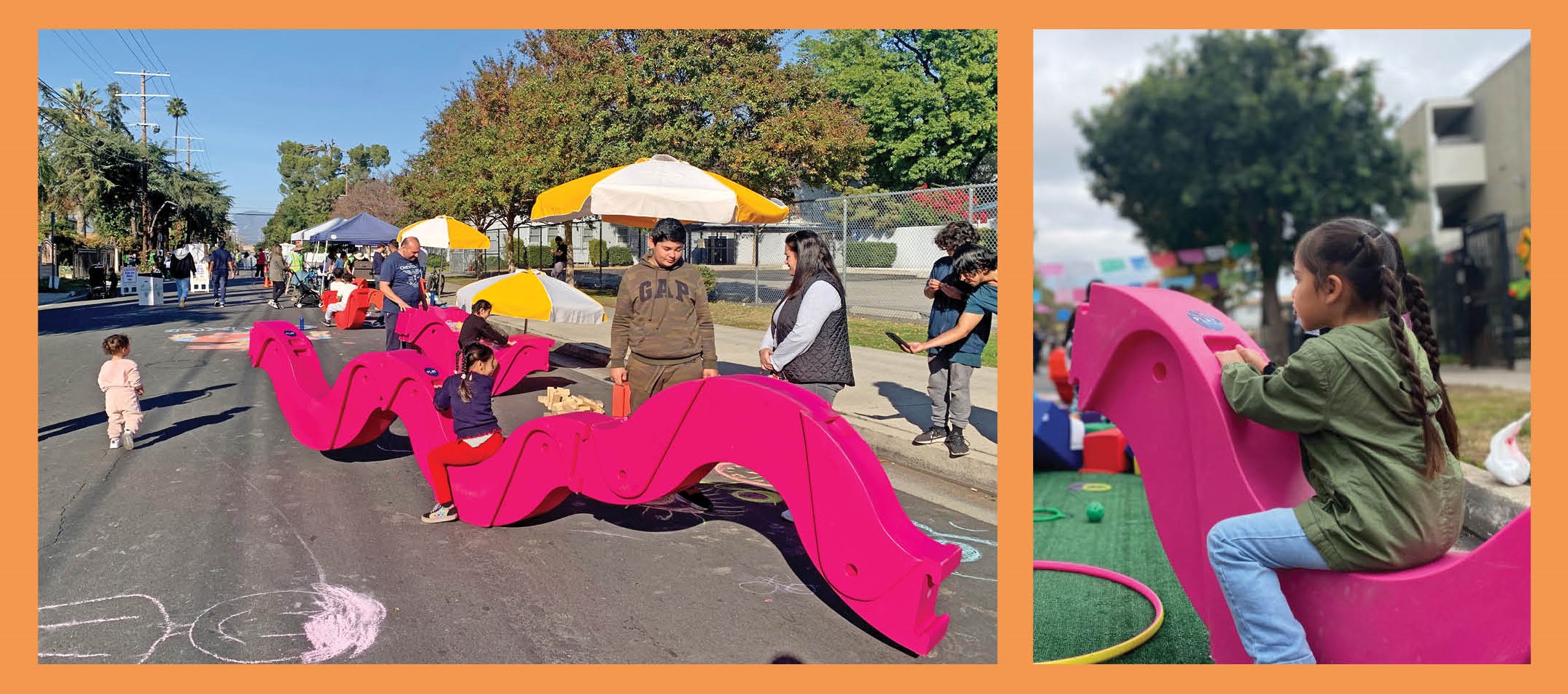
CicLAvia & CicLAmini
LADOT’s partnership with Metro and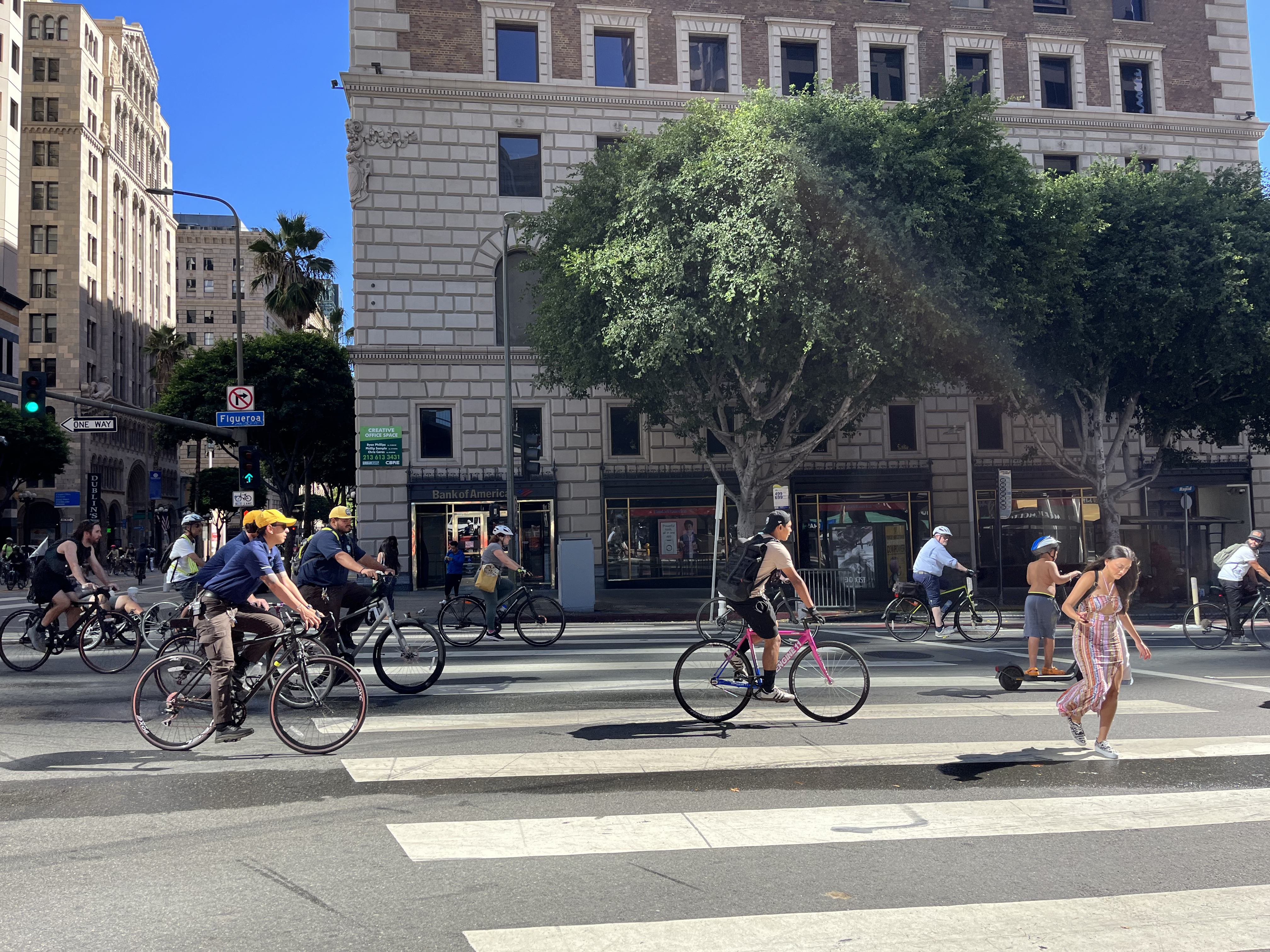 CicLAvia brings out thousands of Angelenos to enjoy miles of car-free streets. In 2023, LADOT Traffic Officers, engineers, and crews helped bring CicLAvia events to the Valley, Mid City, South LA, and DTLA, redesigning City streets into a space for walking, biking, skating, and more. CicLAvia’s community hubs also serve as spaces for residents to connect with City resources. LADOT outreach teams were on hand to share information about local projects and hear from the community directly about their transportation needs.
CicLAvia brings out thousands of Angelenos to enjoy miles of car-free streets. In 2023, LADOT Traffic Officers, engineers, and crews helped bring CicLAvia events to the Valley, Mid City, South LA, and DTLA, redesigning City streets into a space for walking, biking, skating, and more. CicLAvia’s community hubs also serve as spaces for residents to connect with City resources. LADOT outreach teams were on hand to share information about local projects and hear from the community directly about their transportation needs.
The success of past CicLAvia events led to the 2023 launch of the new CicLAmini events: smaller, pedestrian-oriented experiences that took place in North Hollywood and Watts. The compact routes included self-guided walking tours, scavenger hunts, street games, local business engagements, and art and cultural activities.
CicLAvia is more than a recreational event; it is a celebration of the people, places, and spirit that make each Los Angeles community unique.
Move Your Way
This year, LADOT partnered with the City 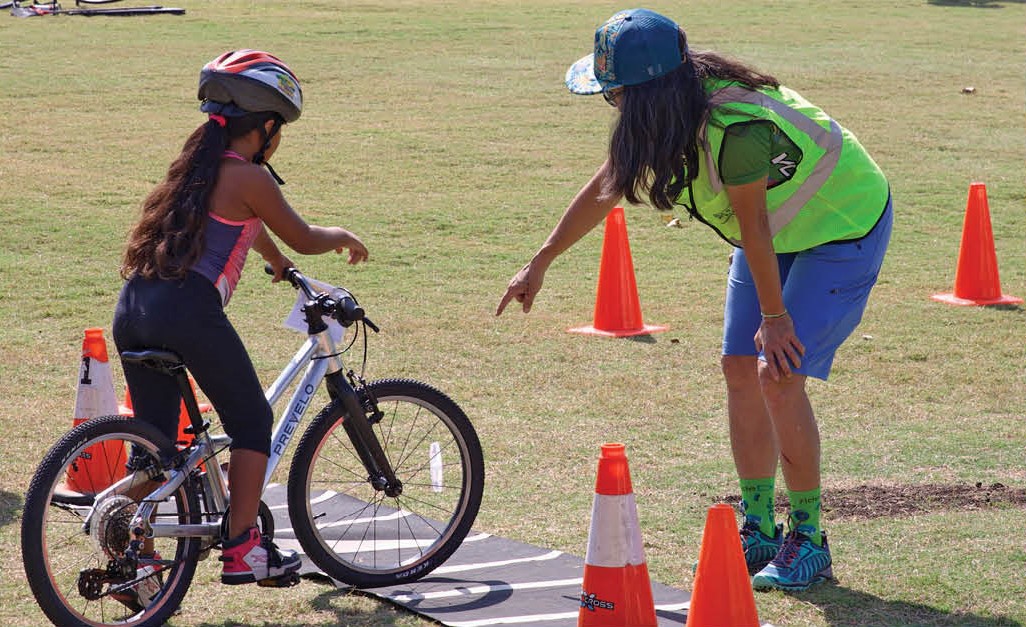 of LA and the City of San Fernando for the first ever Move Your Way open streets festival in Pacoima, Sylmar, and San Fernando. Move Your Way aimed to promote an active lifestyle and community engagement, all while celebrating the joys of biking, walking, and rolling.
of LA and the City of San Fernando for the first ever Move Your Way open streets festival in Pacoima, Sylmar, and San Fernando. Move Your Way aimed to promote an active lifestyle and community engagement, all while celebrating the joys of biking, walking, and rolling.
This first-ever two-city collaboration helped bring the joy of open streets to a wider community and strengthen partnerships throughout our region.
Arroyo Fest
This 2023 also saw the return of Arroyo Fest, the fi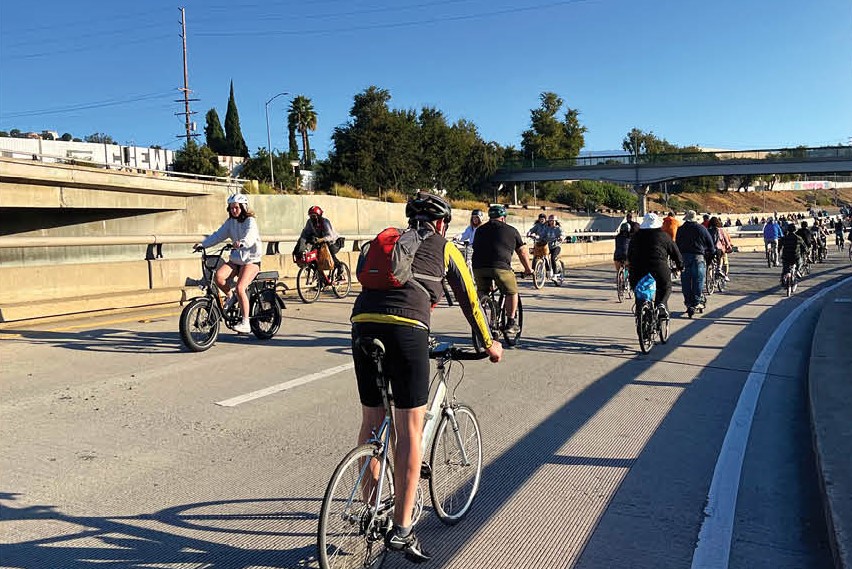 rst time in 20 years that the City of Los Angeles partnered with adjacent cities and Metro to open 7 miles of the historic Arroyo Seco Parkway for people to walk and bike. The transformation of the freeway into a space for bikes and pedestrians is demonstrative of our City’s embrace of a multi-modal transportation future.
rst time in 20 years that the City of Los Angeles partnered with adjacent cities and Metro to open 7 miles of the historic Arroyo Seco Parkway for people to walk and bike. The transformation of the freeway into a space for bikes and pedestrians is demonstrative of our City’s embrace of a multi-modal transportation future.
Building Workforce
LADOT’s success depends on a diverse and talented workforce. Over the past year, the Bureau of Employee Engagement and Performance (BEEP) helped drive new hiring at a record pace to ensure LADOT can rise to meet the needs of Angelenos.
Due to the COVID-19 pandemic, LADOT experienced a hiring freeze in 2020 that left the department with a peak vacancy rate of 24%. Since the release of the freeze, the department has decreased its vacancy rate to 18.6%, hiring 106 full-time and 180 part-time employees in 2023.
Over three-quarters of the part-time positions filled were for crossing guards who play a key role in keeping students safe. The department also filled dozens of engineering positions and several signal electricians to help deliver projects and respond to service requests faster.
The turnaround in hiring stands as a testament to the organization’s resilience, adaptability, and commitment to advancing its mission of ensuring safe and efficient transportation for the residents of Los Angeles.
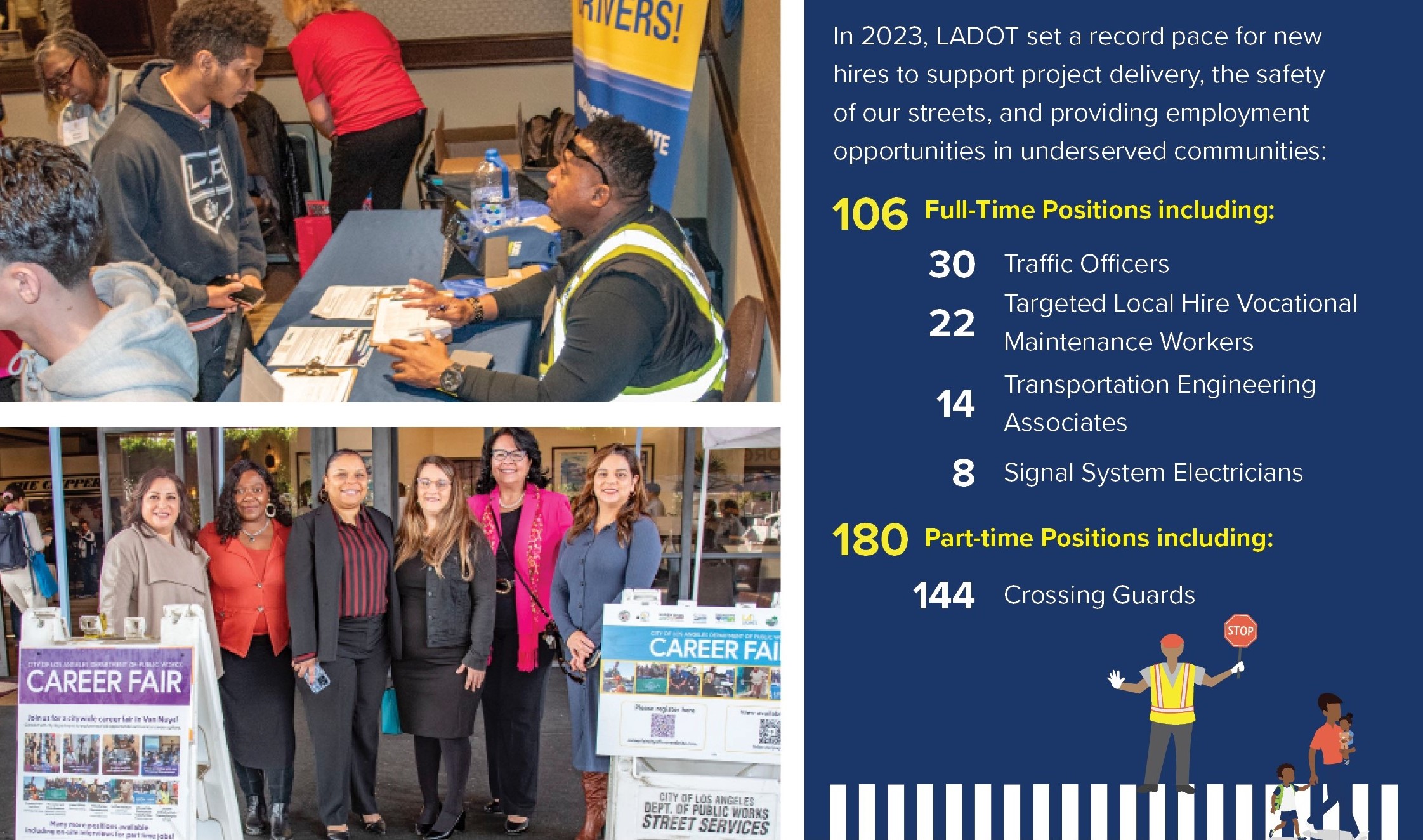
OUTSTANDING PERFORMERS OF 2023
Pride and professionalism in service to the people of Los Angeles are values we ask of all employees of LADOT. We also recognize those individuals who go above and beyond in their duties and serve as examples of excellence. Here are the LADOT employees recognized as Outstanding Performers for 2023.
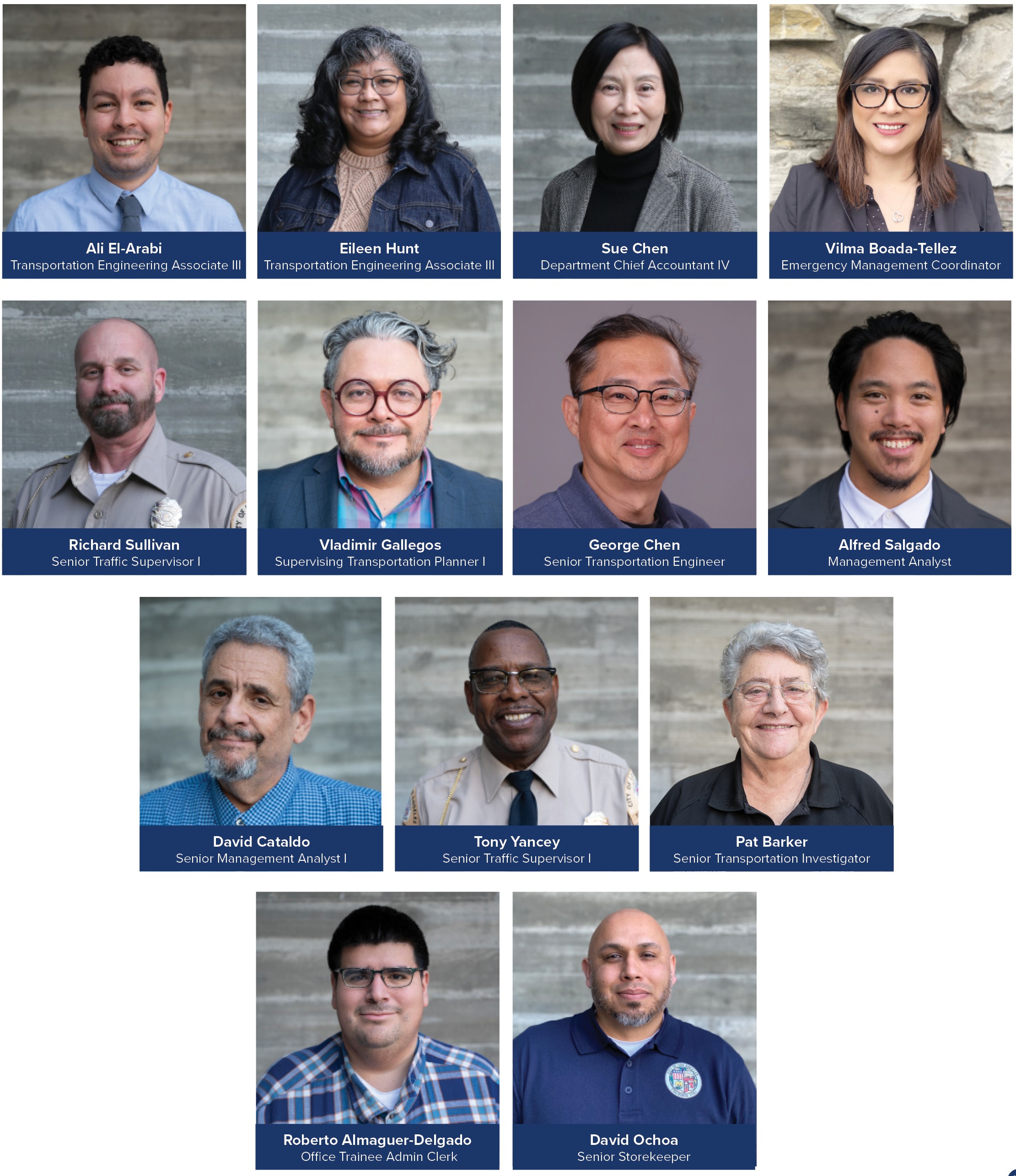
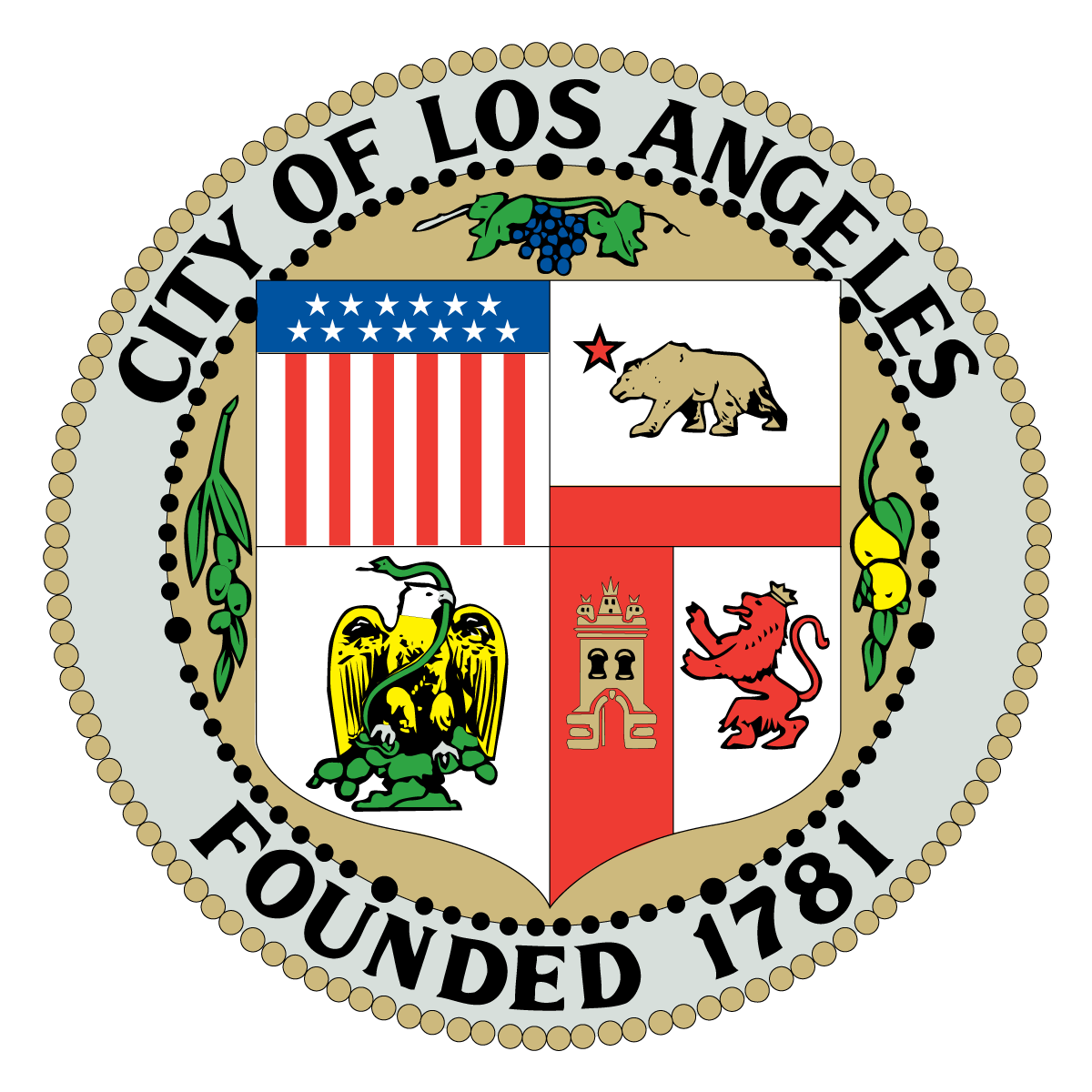

Karen Bass, Mayor
Hydee Feldstein Soto, City Attorney
Kenneth Mejia, City Controller
CITY COUNCIL
Eunisses Hernandez, Council District 1
Paul Krekorian, Council District 2 , Council President
Bob Blumenfield, Council District 3
Nithya Raman, Council District 4
Katy Y. Yaroslavsky, Council District 5
Imelda Padilla, Council District 6
Monica Rodriguez, Council District 7
Marqueece Harris-Dawson, Council District 8
Curren D. Price, Jr., Council District 9
Heather Hutt, Office of Council District 10
Traci Park, Council District 11
John Lee, Council District 12
Hugo Soto - Martinez, Council District 13
Kevin de León, Council District 14
Tim McOsker, Council District 15
BOARD OF TRANSPORTATION COMMISSIONERS
Cris Liban, President
Selika Talbott, Vice President
Jazmin Ortega
Douglas Tohom
Erin Pak
BOARD OF TAXICAB COMMISSIONERS
Andre Colaiace, President
Eric Spiegelman, Vice President
Andrea D. Martinez
Mary Galvan Rosas
Steven Welliver
LADOT ANNUAL REPORT
Produced by the LADOT Communications Office
Colin Sweeney, Public Information Director
Lalageh Mehrabian, Graphic Designer
Jennifer Le, Digital Editor
Alicia McCoy, Contributor
Odalis Perez, Contributor
Pastora Fernandez, Contributor
Sarah Rogers, Contributor
Sebastian Nicolau, Photographer
ladot.lacity.org
@LADOTofficial


